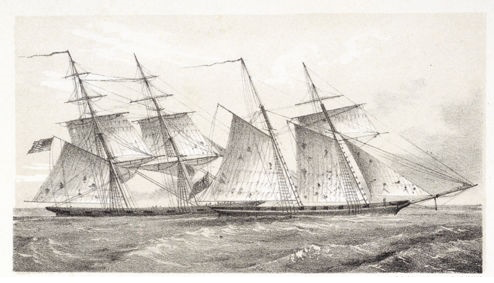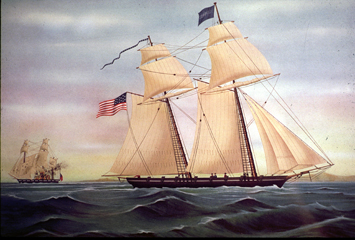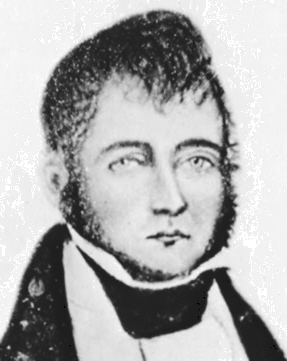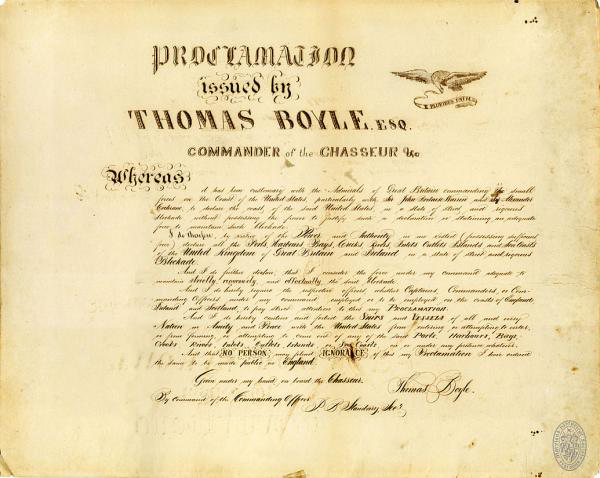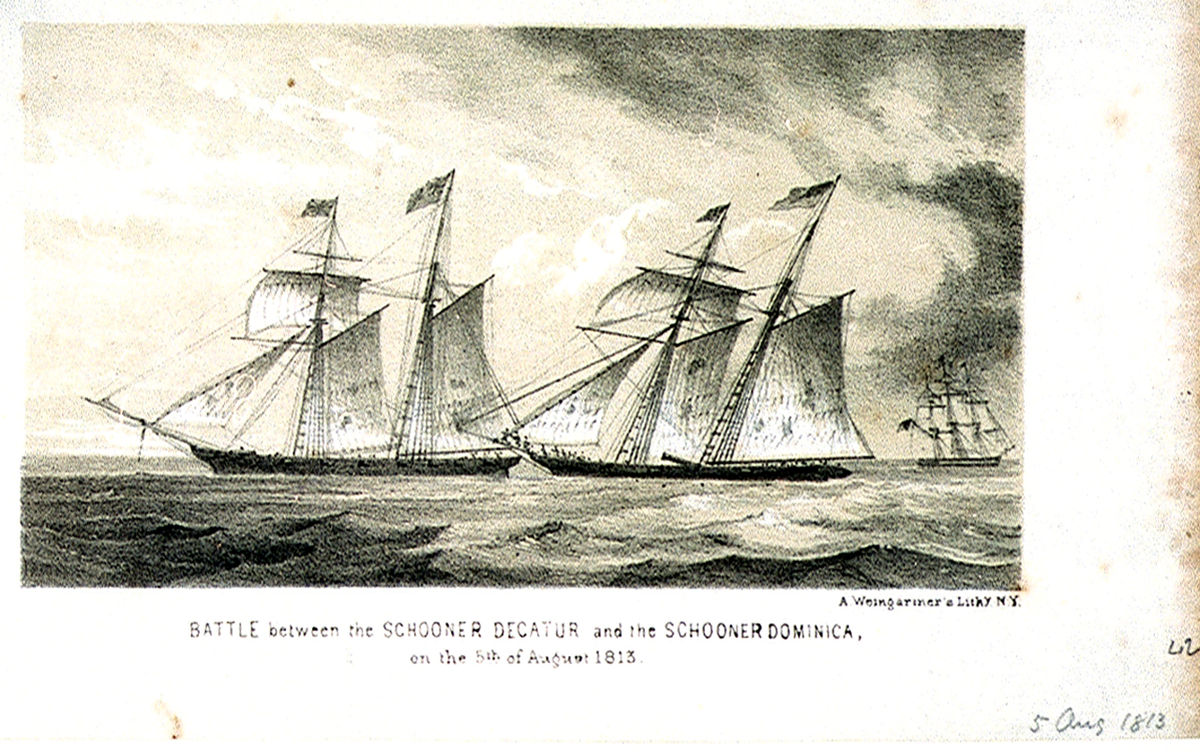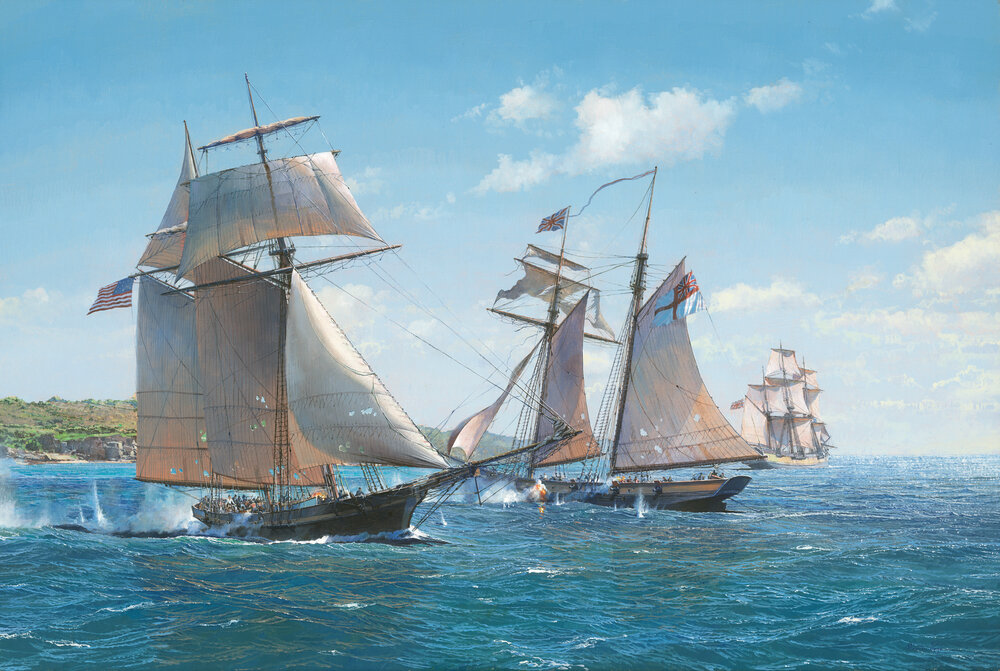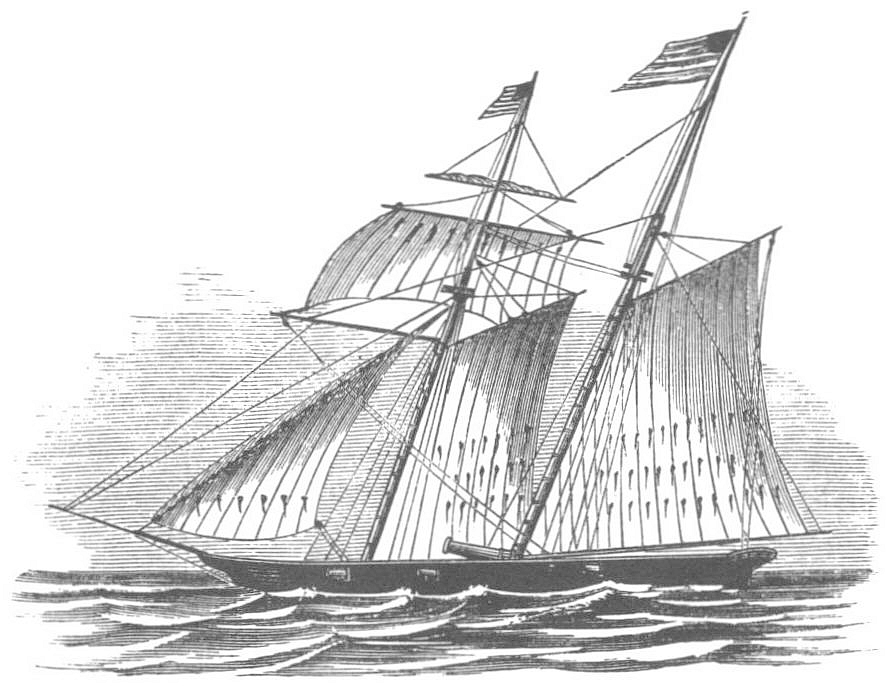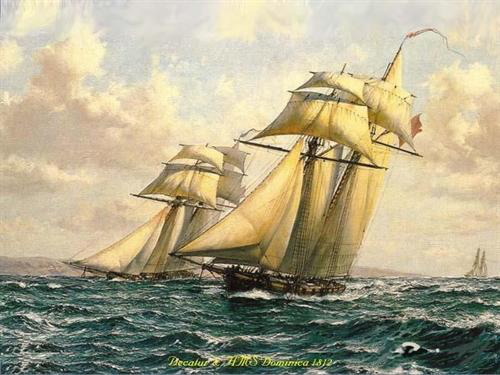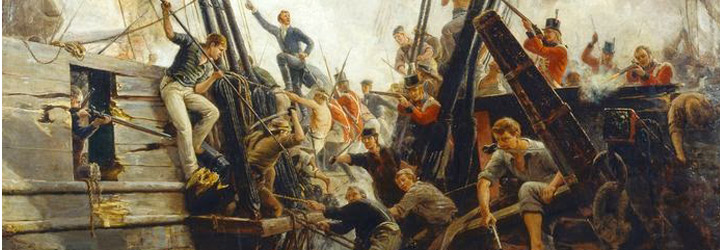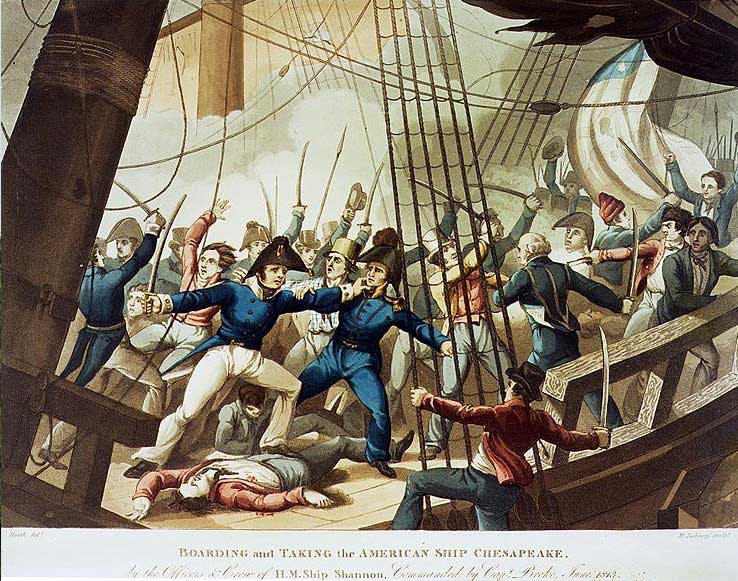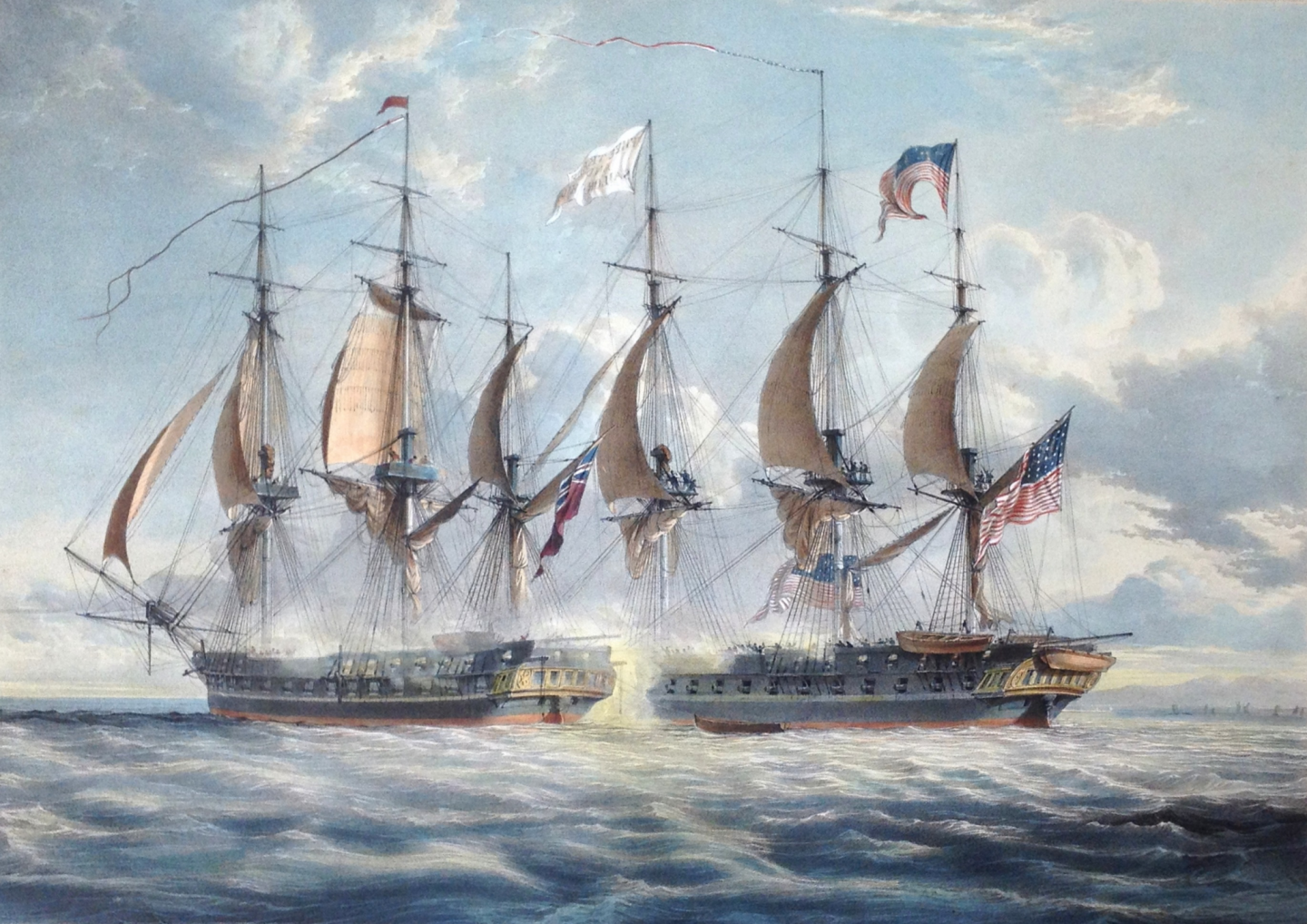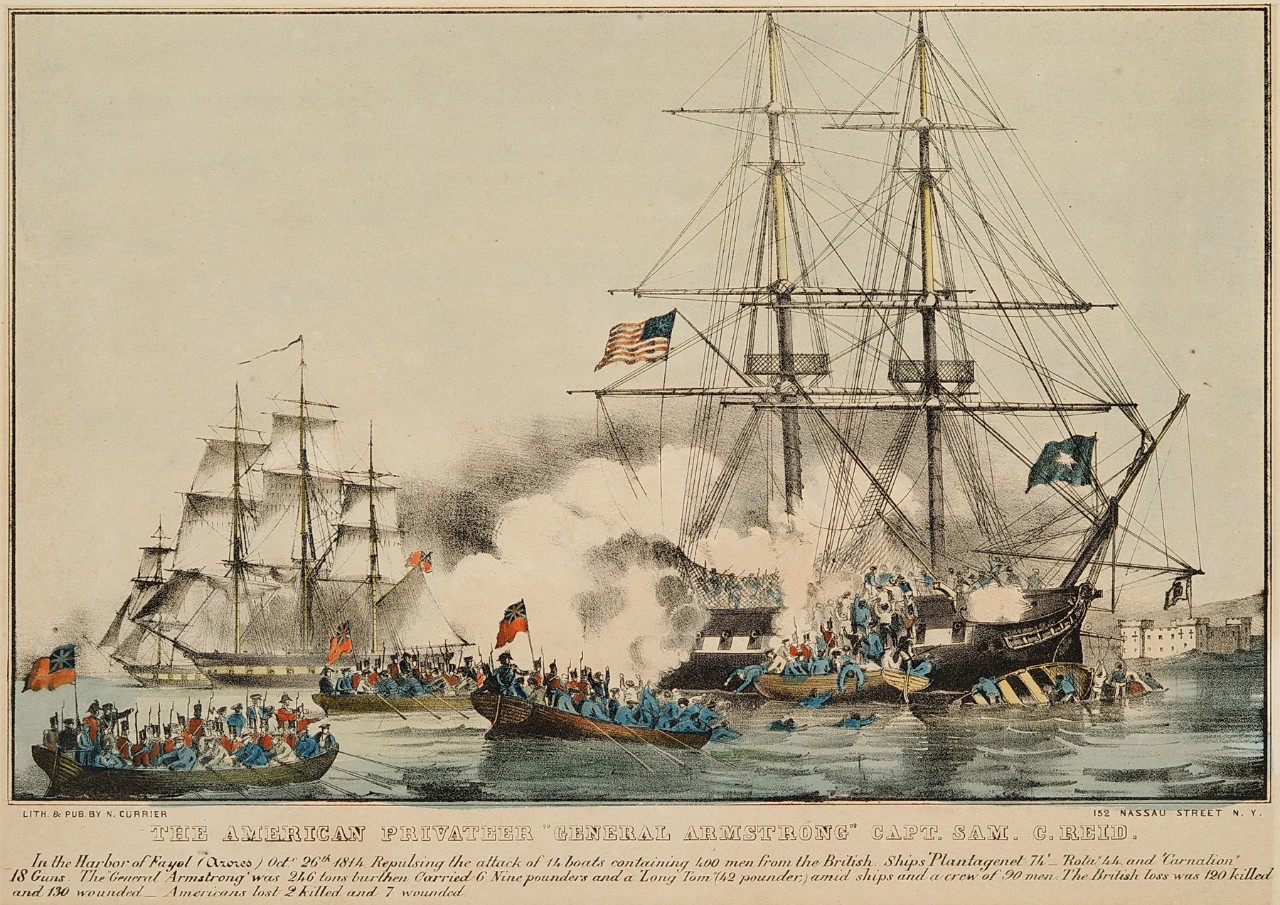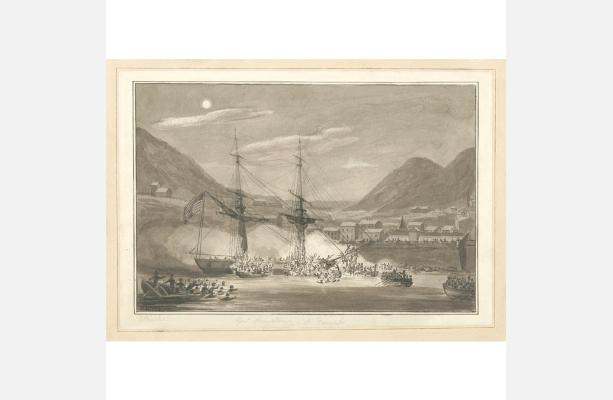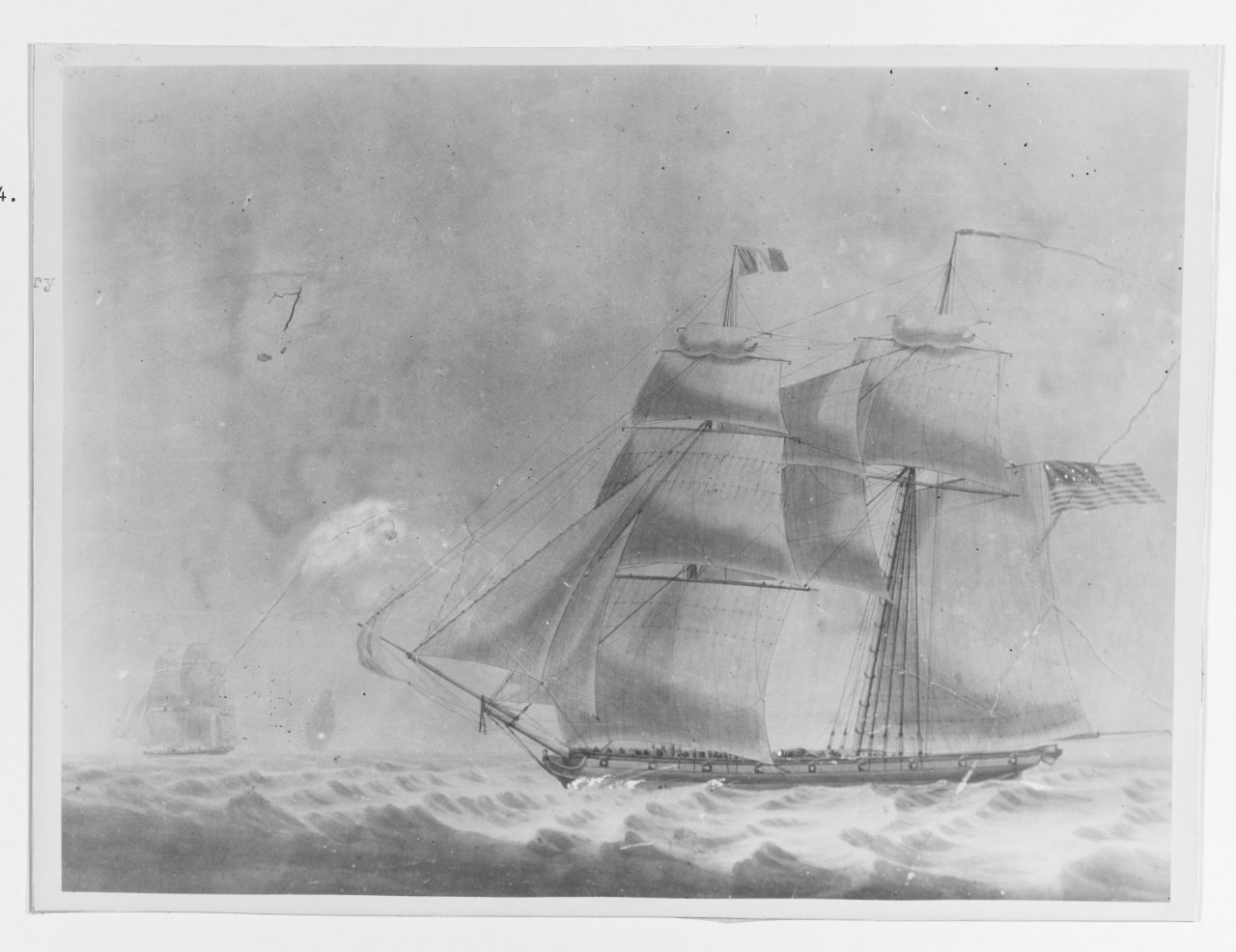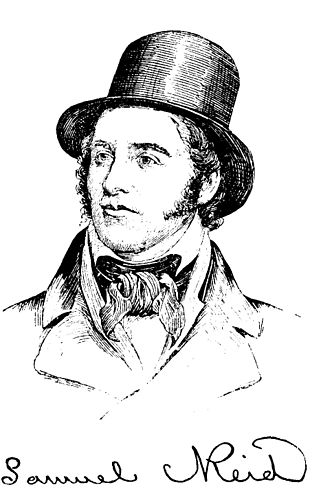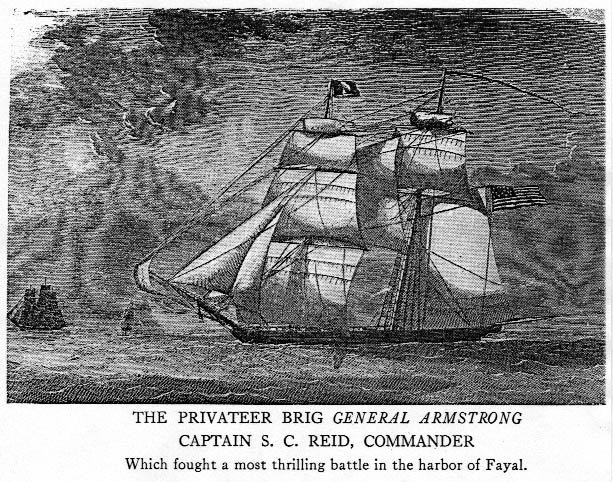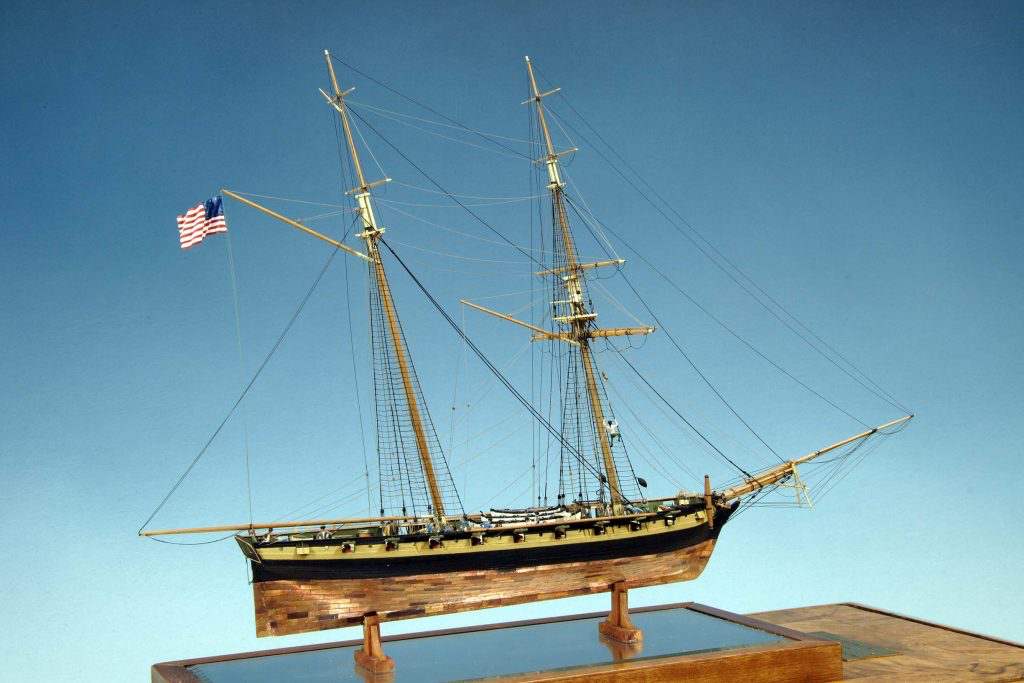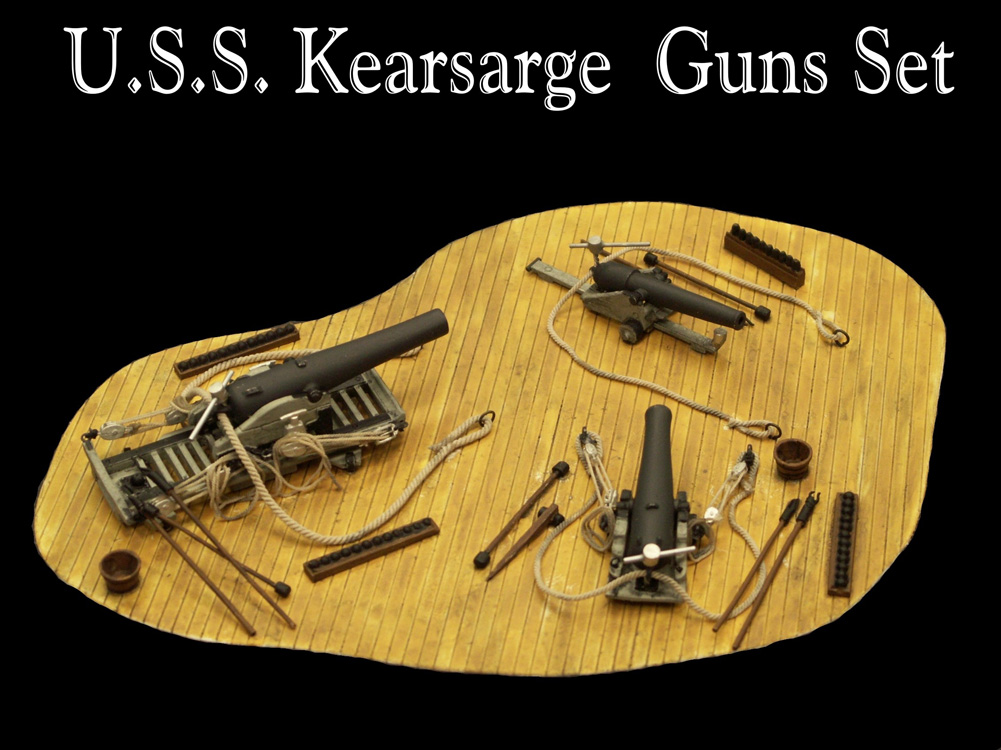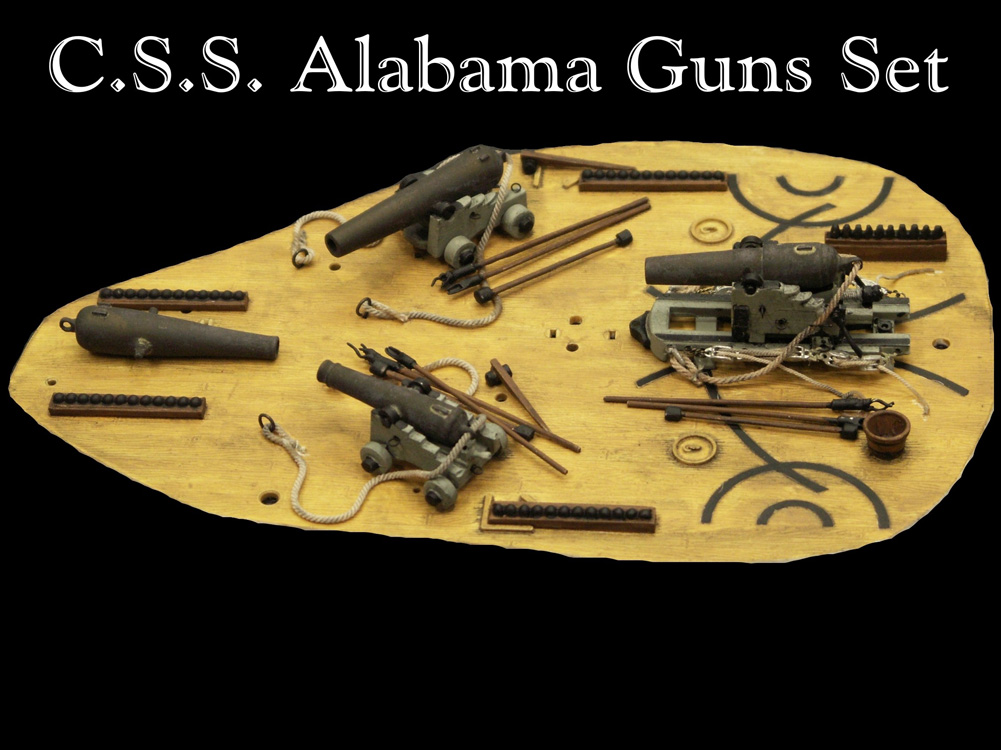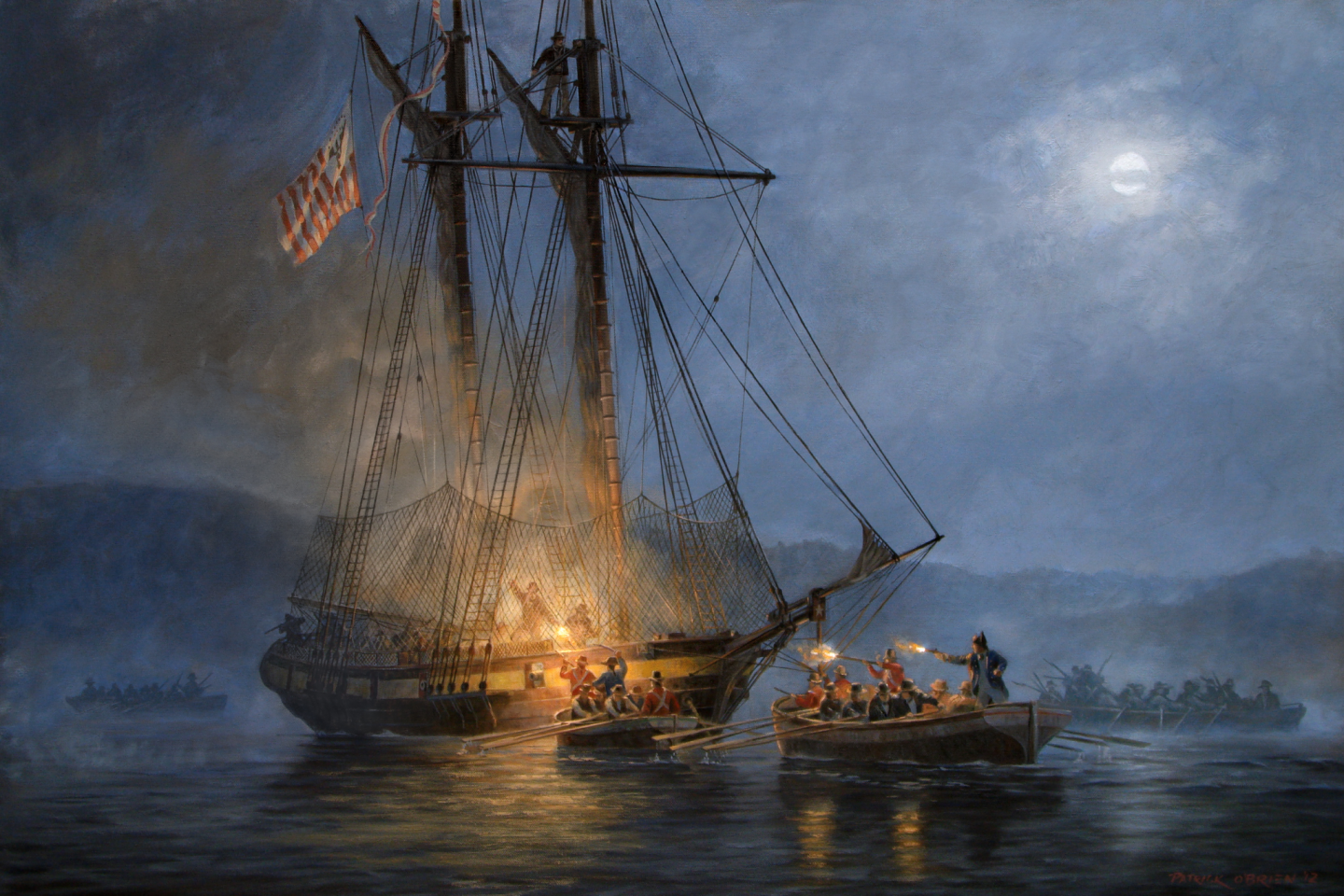-
Posts
2,135 -
Joined
-
Last visited
Content Type
Profiles
Forums
Gallery
Events
Everything posted by uss frolick
-
The cruise of the US Privateer Chasseur! From the same source ... "The History of American Privateers" by Edmond Stanton Maclay. "So great had been the success of Captain Boyle in the Comet that soon after his return from his last. cruise he was placed in command of the formidable privateer Chasseur, in which craft he achieved his greatest renown. This vessel probably was one of the best equipped and manned privateers that sailed in this war. She was familiarly called the Pride of Baltimore, mounting sixteen long 12-pounders and usually carrying a complement of one hundred officers, seamen, and marines. Speaking of her sailing qualities a Baltimore paper said : " She is, perhaps, the most beautiful vessel that ever floated on the ocean. Those who have not seen our schooners have but little idea of her appearance. As you look at her you may easily figure to yourself the idea that she is almost about to rise out of the water and fly into the air, seeming to sit so lightly. She has carried terror and alarm throughout the West Indies, as appears by numerous extracts from the West Indian papers received by her. She was frequently chased by British vessels sent out on purpose to catch her. She was once pretty hard run by the frigate Bareosa; but sometimes, out of sheer wantonness, she affected to chase the enemy's men-of-war of far superior force." In his first cruise in this formidable vessel Captain Boyle captured eighteen merchantmen, nearly all of them of great value. Some of these were the sloop Christiana, of Kilkade, Scotland; the brig Reindeer, of Aberdeen; schooner Favorite, laden with wine; the brig Marquis of Cornwallis; the brigs Alert and Harmony, from Newfoundland; the ship Carlbury, of London, from Jamaica, laden with cotton, cocoa, hides, indigo, etc. (the goods taken from this vessel were valued at fifty thousand dollars); the brigs Eclipse, Commerce, and Antelope, the schooner Fox; the ships James and Theodore; and the brigs Atlantic and Amicus. The Chasseur brought into port forty-three prisoners, having released on parole one hundred and fifty. Captain Boyle's favorite cruising ground was in the British Channel and around the coasts of Great Britain. He seemed to act on the principle which led Farragut to immortal fame half a century later, namely: "The nearer you get to your enemy the harder you can strike." By thus " bearding the lion in his den " the Chasseur had some exceedingly nar- row escapes, but always eluded the enemy by her fine sailing qualities and by the superb audacity of her commander. At one time the privateer was so near a British frigate as to exchange an effective broadside with her, and not long afterward she was completely surrounded by two frigates and two brigs of war. In making a dash to escape, the Chas- seur received a shot from one of the frigates, which wounded three men, but in spite of the danger she finally eluded the enemy. The "superb audacity" of Captain Boyle has already been mentioned, not that it was peculiar to him, for it was shared more or less by all our priva- teersmen, but because it was exhibited by him on this cruise in a unique and emphatic manner. It had been the custom of British admirals on the American stations to issue "paper blockades," declaring the entire coast of the United States to be blockaded. Several of these "paper blockades" had been recently issued by Admiral Sir John Borlaise Warren and by Admiral Sir Alexander Cochrane. On the strength of these foolish proclamations British cruisers were withdrawn, at will, from the ports blockaded and transferred to other points along the coast without at least in the estimation of the English admirals in the least invalidating the blockade. To show the absurdity of these procla- mations, Captain Boyle, while cruising in the English Channel, sent by a cartel to London the following proclamation, which he " requested " to be posted in Lloyd's Coffee House: " By Thomas Boyle, Esquire, Commander of the Private Armed Brig Chasseur, etc. "PROCLAMATION: " Whereas, It has become customary with the admirals of Great Britain, commanding small forces on the coast of the United States, particularly with Sir John Borlaise Warren and Sir Alexander Cochrane, to declare all the coast of the said United States in a state of strict and rigorous blockade without possessing the power to justify such a declaration or stationing an adequate force to maintain said blockade; " I do therefore, by virtue of the power and authority in me vested (possessing sufficient force), declare all the ports, harbors, bays, creeks, rivers, inlets, outlets, islands, and seacoast of the United Kingdom of Great Britain and Ireland in a state of strict and rigorous blockade. "And I do further declare that I consider the force under my command adequate to maintain strictly, rigorously, and effectually the said block- ade. " And I do hereby require the respective officers, whether captains, commanders, or commanding officers, under my command, employed or to be em ployed, on the coasts of England, Ireland, and Scot- land, to pay strict attention to the execution of this my proclamation. " And I do hereby caution and forbid the ships and vessels of all and every nation in amity and peace with the United States from entering or attempting to enter, or from coming or attempting to come out of, any of the said ports, harbors, bays, creeks, rivers, inlets, outlets, islands, or seacoast under any pretense whatsoever. And that no person may plead ignorance of this, my proclamation, I have ordered the same to be made public in England. Given under my hand on board the Chasseur. "THOMAS BOYLE. " By command of the commanding officer. " J. J. STANBTJRY, Secretary." Quite in keeping with Captain Boyle's audacity is the memorial presented by the merchants of St. Vincent to Admiral Durham, in which it is stated that the Chasseur had blockaded them for five days, doing much damage, and requesting that the admiral would sent them at least " a heavy sloop of war." The frigate Barrosa was sent. The memorial gave a pitiful account of how the Chasseur was frequently chased " in vain," at one time by three cruisers to- gether. It then quotes a letter from Martinique stating that this vessel was permitted to supply herself with a new boom, that the captain was treated very politely, that on Sunday he dined with M. Du Buc, the French intendant at the island, " a fine companion, truly, for the governor of such a colony as Martinique." The memorial further complained that the Chasseur ventured within gunshot of the forts of St. Lucia to cut out the transport Lord Eldon, and probably would have done it but for the sloop of war Wolverine, which hove in sight; that the Chasseur burned two sloops "in the face of the island" possibly a West Indian form of the expression " under their noses " ; that she hoisted the Yankee stripes over the British ensign " and played many curious pranks " ; and other complaints in the same tenor. The Chasseur arrived in New York from her European cruise in October, 1814 It was in his last cruise in this war that Captain Boyle gained his greatest reputation for daring and success on the high seas. On February 26, 1815, when the Chasseur was about thirty-six miles to windward of Havana and some twelve miles from land, a schooner was discovered, about eleven o'clock in the morning, to the northeast, apparently running before the wind. This was the English war schooner St. Lawrence, Lieutenant Henry Cranmer Gordon, which, as we remember, was the American privateer Atlas, Captain David Maffitt, captured by boats from Rear-Admiral Cockburn's squadron in Ocracoke Inlet, July 12, 1813, the Atlas having been taken into the British service under the new name. The St. Lawrence proved to be a valuable addition to the enemy's fleet, taking an active part in their many expeditions along the coast and acting as a dispatch boat, in which service her fine sailing qualities gave her every advantage. Here we have an admirable opportunity to compare the relative merits of American and British man-of-warsmen; for the St. Lawrence, being built and equipped by Americans, deprives our friends, the English, of their oft-repeated cry that our vessels were better built, etc. The Chasseur carried fourteen guns and one hundred and two men, as opposed to the St. Lawrence's thirteen guns and seventy-six men. Both vessels were schooners. When sighted by Captain Boyle, the St. Lawrence was bearing important dispatches and troops from Rear-Admiral Cockburn relative to the New Orleans expedition. Captain Boyle promptly made sail in chase, and soon discovered the stranger to be a war craft having a convoy in company, the latter being just dis- cernible from the masthead. By noon the Chasseur had perceptibly gained on the chase, which to the Americans appeared to be a long, narrow pilot-boat schooner with yellow sides. When she made out the Chasseur she hauled up more' to the north, evidently anxious to escape. At half past twelve Captain Boyle fired a gun and showed his colors, hoping to ascertain to what nation the chase belonged, but the latter paid no attention to the summons, and in her efforts to carry a greater press of sail her fore-topmast was carried away. At the time this happened she was about three miles ahead. Her people promptly cleared the wreck away and trimmed her sails sharp by the wind. Owing to this accident the Chasseur drew up on the chase very fast, and at one o'clock the latter fired a stern gun and hoisted English colors. As the stranger showed only three ports on the side nearest to the Chasseur, Captain Boyle got the impression that she was a " running vessel " bound for Havana which in all probability was poorly armed and manned. Acting on this impression he increased his efforts to get alongside, confident of making short work of her. This mistake of the Americans was encouraged by the fact that very few men were seen on the deck of the stranger. As neither Captain Boyle nor his officers anticipated serious fighting, the regular preparations for battle were not made. At 1.26 P. M. the Chasseur was within pistol shot of the enemy, when the latter suddenly triced up ten port covers, showing that number of guns and her decks swarming with men wearing the uniform of a regular British man-of-war. Evidently they had been carefully concealed during the chase. It took the enemy scarcely five seconds to give three cheers, run out their guns, and pour in a whole broadside of round shot, grape, and musket balls into the Chasseur. For once, at least, the crafty Yankee skipper had been caught napping. He was fairly and squarely under the guns of an English man-of-war, so that either prompt surrender or fight were the only alternatives. It did not take Captain Boyle an instant to decide on the latter course, and, although taken somewhat by surprise, he made the best of the situation and returned the enemy's fire with both cannon and musketry. Believing that his best chance for victory was at close quarters, Captain Boyle endeavored to board "in the smoke of his broadside; but the Chasseur, having the greater speed at that moment, shot ahead under the stranger's lee. The latter put up his helm for the purpose of wearing across the privateer's stern, with a view of pouring in a raking fire. Perceiving the enemy's object, Captain Boyle frustrated the maneuver by putting his helm up also. The Englishman now forged ahead and came within ten yards of the privateer, the fire of both vessels at that time being exceedingly destructive. At 1.40 P. M. Cap- tain Boyle, seizing a favorable moment, put his helm to starboard and called on his men to follow him aboard the enemy. Just as the two vessels came to- gether W. N. Christie, prize master, jumped aboard the stranger's deck, followed by a number of other Americans, but before they could strike a blow the English surrendered. The St. Lawrence, according to British accounts, mounted twelve short 12-pounders and one long 9-pounder and had a complement of seventy-five men, besides a number of officers, soldiers, and civilians as passengers, who were bound for the British squadron off New Orleans. According to the report of her commander she had six men killed and seventeen wounded, several of them mortally. According to American accounts the English had fifteen killed and twenty-five wounded. The St. Lawrence was found to be seriously injured in the hull, while scarcely a rope was left intact, such had been the accuracy and rapidity of the Chasseur's fire. The privateer also suffered considerably in her sails and rigging, while five of her crew were killed and eight wounded, among the latter being Captain Boyle himself. In view of the fact that the action lasted only fifteen minutes these casualties reveal, better than words, the desperate nature of the encounter. The Chasseur mounted six 12-pounders and eight short 9-pounders ten of her original sixteen 12-pounders having been thrown overboard when the privateer was chased by the British frigate Barrosa. They were replaced by the 9-pounders which had been taken from a prize. " From the number of hammocks, bedding, etc., found on board the enemy," said Captain Boyle, in his official report to one of the owners of the Chas- seur, George P. Stephenson, of Baltimore, " it led us to believe that many more were killed than were reported. The St. Lawrence fired double the weight of shot that we did. From her 12-pounders at close quarters she fired a stand of grape and two bags containing two hundred and twenty musket balls each, when from the Chasseur's 9-pounders were fired 6- and 4-pound shot, we having no other except some few grape." In closing his report, Captain Boyle speaks in the highest terms of the gallantry of his first officer, John Dieter, and of the second and third officers, Moran and Hammond N. Stansbury. That night the masts of the St. Lawrence went by the board, and having no object in bringing home so many prisoners Captain Boyle made a cartel of his prize and sent the prisoners by her into Havana. After this gallant affair the Chasseur returned to the United States with her hold filled with valuable goods. She arrived in Baltimore, April 15, 1815, where it was learned that a treaty of peace had been signed. So well pleased were the British officers at the treatment they received from the Americans that Lieutenant Gordon issued the following memorial or certificate dated: "At Sea, February 27, 1815, on board the United States Privateer Chasseur: In the event of Captain Boyle's becoming a prisoner of war to any British cruiser I consider it a tribute justly due to his humane and generous treatment of myself, the surviving officers and crew of His Majesty's late schooner St. Lawrence, to state that his obliging attention and watchful solicitude to preserve our effects and render us comfortable during the short time we were in his possession were such as justly entitle him to the indulgence and respect of every British subject. I also certify that his endeavors to render us comfortable and to secure our property were carefully seconded by all his officers, who did their utmost to that effect." The Chasseur fights HMS St. Lawrence! The Chasseur privateer: Captain Thomas Boyle: That infamous proclamation!
-
Another similar fight, this time between two schooners of war, being the battle between the American Privateer Decatur, of Charleston, SC, and HMS Dominica. This is taken from a scanned classic "The History of American Privateers" by Edmond Stanton Maclay. The formatting is weird, and the the scanners misspelled many words, but still ... I corrected as much as I could. Note that plans of the Dominica appear in Howard Chapelle's "The Search For Speed Under Sail": "The Dominica was a three-masted schooner carry- ing twelve short 12-pounders, two long 6-pounders, one brass 4-pounder, and a short 32-pounder on a pivot. She was manned by eighty-eight men and boys. On September 4, 1812, this cruiser captured the 8-gun armed schooner Providence, Captain N. Hopkins, of Providence. The Providence is not credited with any prizes, being taken shortly after leaving port. In the chase of ten hours, Captain Hopkins had thrown overboard all his guns on the leeward side. At the time the Dominica fell in with the Decatur she had under her convoy the Government packet ship Princess Charlotte, from St. Thomas for England, and the merchantman London Trader, from Surinam homeward bound. The Princess Charlotte carried a formidable armament, and the London Trader also was well armed. The Decatur left port in the summer of 1813 on a general cruise against British commerce, and early in August she was in the track of British West India traders homeward bound. Early on the morning of August 5th, when in latitude 23 4' north, longi- tude 67 0' west, or a little to the south of the Bermudas, the Decatur was heading northward under easy sail, hoping for some prize to appear. About 10.30 A. M. the man at the masthead reported a sail bearing away to the south, and shortly afterward another, steering in the same direction, was sighted. Captain Diron promptly tacked southward, with a view of getting the weather gauge of the strangers, so that, should they prove to be British cruisers, he would have the advantage in a chase. This precaution was rendered doubly necessary, as the fact of two vessels cruising in company rendered it prob- able that they were the enemy's sloops of war, for so astonishing had been the victories of the little American navy, and so appalled had the British pub- lic become at the results of the war as far as it pertained to their navy, that their Lordships of the Admiralty had directed British 38-gun frigates to avoid the dreaded American 44-gun ships, while their sloops of war were to sail in pairs. For this reason Captain Diron approached the strangers with caution, knowing that there was a strong probability of their being a couple of Brit- ish sloops of war. The danger of approaching a stronger force, however, did not prevent the Americans from coming to closer range, and at 11 A. M. it was seen that the sails were a ship and a schooner, which, on making out the sails of the Decatur, had changed their course to the north so as to meet her. The three vessels slowly reduced the distance between them, and at 12.30 P. M. the Decatur, having secured a position a little to windward, and being almost within gunshot, wore round and ran a little to leeward, upon which the schooner showed English colors. Captain Diron was now satisfied that he had an English war schooner to deal with and that the ship was under its protection. Half an hour later he wore again, still keeping the weather gauge, and about 1.30 P. M. the stranger fired a shot, which fell short. Knowing that the British commander had a heavier armament than the privateer, but believing that he had the greater number of men to man his ship, Captain Diron determined to have the fight at the closest quarters, and to carry the Englishman by boarding. Accordingly he cleared for action, sent his men to quarters, loaded all his guns, and hoisted American colors. To make sure that no man could leave his post and run below, Captain Diron, after having got all his ammunition, water, sand, etc., on deck, ready for instant use, ordered all the hatches closed. It was the plan of the Americans to get as close to the enemy as possible before firing a shot, deliver their entire broadside and a volley from their small arms, and then to board in the smoke. In order to secure the British ship alongside grappling irons were in readiness to be thrown aboard. Having made all his arrangements for the battle, Captain Diron about 2 P. M. wore ship, with a view of passing under the stern of the enemy and giving a raking fire, but as the schooners neared each other the Englishman luffed and gave his broadside, most of the shot passing over the American. This is only another indication of the overconfidence of the British naval officer in this war. So confident was Lieutenant Barrett of taking the American that he ordered his gunners to aim at the Yankee's rigging so as to prevent her from running. But if this was the Englishman's motive in firing so high he soon had cause to repent it, for at 2.15 P. M. the Americans began the fire of their long torn, and as it was aimed with coolness and deliberation, within half- gunshot distance, the effect in so small a vessel was serious, disabling several of the Englishman's guns, besides injuring many men. At all events, it speedily changed the English commander's tactics, and the few guns that remained mounted on that side were now trained on the privateer's hull. The destructive work done by the American's long torn, however, had given Captain Diron the advantage, and, so far from evincing a disposition to run away, he soon discovered that that was the purpose of his opponent, and in order to prevent it he filled away so as to bring his bowsprit over the enemy's stern. The English endeavored to frustrate this by directing a whole broadside at the advancing Yankee, but they were too excited, or their gun- nery was so poor that the shot did little or no execution. Had they taken good aim the effect of those guns at such a short distance would have been terrific. The Decatur could respond to this fire only with her long torn, but as that was discharged with the usual skill and coolness of American gunners it effected far greater damage than the Englishman's broadside. It was now 3 P. M., and the vessels were so near to each other that the voices of the officers aboard the British ship, urging their men to renewed energy, could be distinctly heard. Captain Diron then order his boarders to leave their guns and assemble forward, arm themselves with muskets and cutlasses, and be in readiness to spring upon the enemy's decks. 1813. The British at this stage of the battle evidently realized the seriousness of the fight, for their officers could be heard warning their gunners to take better aim, and to fire into the Yankee's hull instead of his rigging, as heretofore. The result of this admonition was seen in the effect of the next broadside which the enemy delivered. The shots hulled the Decatur, killed two of her crew, and materially injured her sails and rigging. This broadside did more damage than all the others. It also prevented Captain Diron from carrying out his plan of boarding; for, some of his ropes being severed, his sails became temporarily unmanageable. Repairs were quickly made, and, though foiled in their attempt to board, the Americans renewed the action with their long torn and 12-pounder, believing that an opportunity would yet be offered them to settle the fight on the Englishman's deck. After delivering their first effective fire, the Englishmen filled away so as to prevent the Americans from boarding, while Captain Diron doggedly followed close under their stern, determined to board at any cost. In this way, bow to stern, the two craft ran several minutes, neither side being able to main- tain a very effective fire. The Americans now made another attempt to board, but it was frustrated in the same manner as the first. But the last move made by the British schooner, in her endeavor to avoid boarding, gave the Decatur the advantage in sailing, and, persisting in following close in the wake of his enemy, Captain Diron finally had the satisfaction of seeing his craft gradually overhaul the Englishman. Again he called for his boarders, and at 3.30 P. M. the Decatur ran her bow- sprit over the enemy's stern, her jib boom piercing the Englishman's mainsail. This was the signal for the Americans to board, and while some of them poured in a heavy fire of musketry others, led by Vincent Safitt, the prize master, and Thomas Wasborn, the quartermaster, clambered along the bow- sprit and sprang to the Englishman's deck. Then began a terrible scene of slaughter and bloodshed. The two crews were soon intermingled in an inextricable mass, which the narrow decks of the schooner kept compact as long as the struggle lasted. Nearly two hundred men and boys armed with pistols, cutlasses, and muskets were now shout- ing, yelling, and cheering, and slashing at each other in a space not more than twenty feet wide and eighty feet long. One of the first to fall on the side of the enemy was their gallant commander, Lieutenant Barrett, a young man not more than twenty-five years old, who had conducted himself from the beginning of the fight with conspicuous gallantry, notwithstand- ing his contempt for the Yankee sailor. He had received a bad wound early in the action, two musket balls having passed through the left arm. But this did not prevent him from remaining at his post. He was urged several times by his surviving officers to surrender, but refused to do so, avowing his deter- mination not to survive the loss of his vessel. A few moments before he received his fatal wound he severely injured one of the American officers with a saber cut. The sailing master, Isaac Backer, and the purser, David Brown, of the Dominica, also were killed, while Midshipmen William Archer and Wil- liam Parry were wounded. In fact, the only English officers not killed or wounded were the surgeon and one midshipman. It was not until eighteen of the Dominica's crew were killed and forty-two wounded that the few survivors were induced to surrender. A total of sixty killed or wounded in a crew of eighty-eight fully attests the desperate nature of the struggle and the gallantry of the men against whom the Americans fought. Even with this appalling percentage of killed and wounded the Englishmen can not be reported as having surrendered for the Americans hauled down the colors with their own hands. On the part of the privateer five men were killed and fifteen wounded, which disparity of casualties is to be ascribed solely to the superior sea- manship of Captain Diron and the better marksman- ship of the Americans, both with the cannon and small arms. That this was in truth a battle royal will be seen by comparing it with the regular naval actions between sloops of war in the conflict: While the battle between the American privateer and the British cruiser was raging the commander of the Princess Charlotte did not deem it his place to take part in the fight, and for over an hour remained a passive spectator. But as soon as it was seen that the American was the victor the Princess Charlotte tacked to the south, and by sunset had disappeared. She had left St. Thomas for England, and was to be under the escort of the Dominica until well clear of the American coast, when she had intended to proceed on her voyage alone. Arriving in Eng- land, the commander of the packet reported that he had left " the Dominica in hot pursuit of a Yankee privateer." As soon as victory was assured Captain Diron employed all the men he could in repairing damages; for capturing a ship and taking her safely into port when the coasts of the United States were swarming with British cruisers were two very distinct achievements. Having given the dead a sailor's burial, and having attended the wounded (the English receiv- ing quite as much attention as the Americans), Captain Diron headed for Charleston. The Decatur and the Dominica made land near Georgetown, and running down the coast crossed Charleston bar safely August 20th, the Dominica appearing under the colors she had taken from the Providence. For several days before two English brigs of war had been hovering off the port; but, fortunately, on the day Captain Diron approached they had been drawn off in chase to the south. Arriving in port, Captain Diron heard that the British merchant ship London Trader had arrived safely at Savannah. This ship had been sailing in company with the Dominica and the Princess Charlotte when they fell in with the bold Decatur. The London Trader made her escape while the American privateer was engaged in fighting the Dominica, but on the following day Captain Diron fell in with and captured her. She had on board a cargo consisting of two hundred and nine hogsheads of sugar, one hundred and forty tierces of molasses, fifty-five hogsheads of rum, seven hundred bags of coffee, and sixty bales of cotton. Captain George Coggeshall, who commanded several privateers in this war, happened to be in Charleston about the time the Decatur entered that port with her prize, and, in conversation with the captors and prisoners, learned many details of this action. He said: "The surviving officers of the Dominica attributed the loss of their vessel to the superior skill of the Decatur's crew in the use of musketry and to Captain Diron's adroit manner in maneuvering his schooner during the action, which rendered the Englishman's carriage guns in a manner almost useless. It was acknowledged by the English prisoners that during their captivity they were treated with great kindness and humanity by Captain Diron, his officers and crew, and that the utmost care and attention were paid to the sick and wounded. The crew of the captured vessel were all fine-looking young men. There were among them eight or ten boys. To see this youthful crew on their arrival at Charleston in their mangled condition was enough to freeze the blood with horror of any person not accustomed to such sanguinary scenes. Among the crew was a small boy, not eleven years old, who was twice wounded while contending for victory on the deck of the Dominica. I saw daily one of the wounded English midshipmen with his arm in a sling, who had the privilege of walking about the city on his parole of honor." The Dominica subsequently was fitted out as a privateer, carrying four guns and thirty-six men, but on May 23, 1814, she was captured by the British ship of the line Majestic. In November, 1813, the Decatur got to sea again, but after a cruise of eighty days she returned to Charleston without having taken one vessel. She made another venture in this war, but was captured June 5, 1814, by the British Frigate Rhin off Mona Passage, after a chase of eleven hours." Two modern depictions of the fight: The Privateer Decatur in a contemporary engraving. Now that's what I call a long tom!
-
Force9, yea, old billie-jim doesn't say much about the General Armstrong fight, maybe he ran out of ink ... I looked in both his Naval History of Great Britain Volume 6, and in his earlier Naval Occurrences ... nada. Matrim, was this the sword in question? 0 by Stephen Duffy, on Flickr Legend has it, that whenever Broke's sword is drawn from it's scabbard, somewhere, a yankee sailor proclaims "Ow! What was that?"
-
The Shannon/Chesapeake battle was indeed one of the more interesting fights of the age. Although the two ships were as close as any two combatants in the age of sail in size and force, there were overlooked factors contributing to Broke's victory. First and foremost, the Shannons were just amazingly good, and they were led by the most capable man in the Royal Navy. Few other frigates could have stood against them. They earned their victory, and it was fair. But on the American side, there were other things to consider: When the Chesapeake sailed out of Boston Harbor to give battle that June 1st, 1813, her captain and crew had served together at sea for fewer hours, than the British crew had served together for years! There were five American courts martial and one preliminary court of inquiry that looked into the causes of the humiliating loss. What stands out in all of them, is that the officers did not know the names of the sailors in their division, or even the gun crews. Many sailors testified that they had not yet served at quarters together. This was a recipe for disaster. This was Lawrences fault, because his people were not ready. Lawrence was brave, but cocky, and he paid with his life. Lawrence threw his opening salvo away needlessly. One officer testified that when they approached the Shannon, their long 18-pounders had been loaded with one round and one grape shot in each. At the last minute, Lawrence ordered one canister and one bar shot to be added on top of this load. Amazingly, none of these quadruple-shotted cannon exploded during the first broadside, but most of the projectiles imbedded themselves into the Shannon's hull - and few penetrated. Were they aimed true, and had they all passed through the Briton's side, as they would have done had the guns remained double-shotted, the British loss would have been much higher. Shannon's first discharge was reportedly their most lethal, and reportedly instantly destroyed the American crew's morale. The Chesapeake's wardroom had been in turmoil long before she set sail. Her previous commander, Samuel Evans, had to relinquish his command due to chronic bouts of blindness, the result of a cutlass blow to the face in a duel. Lawrence was given his frigate as a reward for sinking HBM Brig Peacock, and when he came aboard, he quickly replaced many of Evan's old officers in important positions of command with his own followers from the Hornet, causing great anger. Politics played a role in this, too. Lawrence and his followers were Federalists (Hamilton-ites), while Evans and his old hand-picked wardroom were Republican/Democrats (Jefferson-ians). Things became so heated that First Lieutenant Page resigned in a huff, while another of Evans's lieutenants left the frigate too, supposedly on "sick leave". After the disastrous battle, the senior surviving Evans-era officer, William Budd, accused the senior Lawrence surviver, William Cox, of cowardice. Cox was court martialed, found guilty, and dismissed the service. Just before the battle, the old hands had refused to go to their quarters, because the overdue prize money due them from the previous cruise had yet to be distributed. Lawrence gave in to their demands, and had the purser pay them. Many of them then handed their money over to Lieutenant Budd for safe keeping. But Budd decided it was okay keep the money belonging to some the killed sailors afterwards, causing a letter of complaint by one of the survivors to be sent to the Secretary of the Navy. In a battle that lasted, at most, three broadsides, the Americans managed to inflict about 75 casualties on the victorious British in only somewhere between 12 to 15 minutes - more than Constitution inflicted on the Guerriere in 90 minutes. Still, the Americans lost about 170 casualties all told, including her captain, most of her marines, and near every officer on deck, enough to insure defeat in any US frigate.
-
While I can't find any contemporary illustrations of the battle, the P-de-N did have a near-sister brig, called the General Armstrong, which fought its own similar engagement off Fayol against the boats of three British men of war! She too won, but her captain, Samuel Reid, had to scuttle the General Armstrong and escape ashore: From Wikipedia: General Armstrong was based in New York City and crewed by about 90 men. Captain Tim Barnard commanded the ship in 1812. Guy Richards Champlin led the ship from 1813 through July 1814, followed by Captain Samuel Chester Reid until the ship's September 1814 scuttling in Faial.[3] She was armed with seven guns, including a 42-pounder Long Tom cannon. On 11 November 1812 the General Armstrong—armed with 16 guns and 40 men—attacked the English ship Queen. Queen, headed by an individual named Conkey,[4] was sailing from Liverpool to Suriname with cargo valued at £90,000. Her crew resisted and did not strike her colours until the captain, first officer, and nine of the crew were killed. Queen was possibly one of the most valuable prizes captured by American privateers during the War of 1812. A prize crew began sailing Queen to the United States, but wrecked it off the Nantucket coast.[3] On 11 March 1813 the General Armstrong was sailing in the mouth of the Suriname River when she encountered a vessel the crew presumed to be a British privateer but was, in fact, the British sloop HMS Coquette.[5] The ensuing battle severely damaged General Armstrong. Its captain Guy Richards Champlin was injured and threatened to blow up the ship if the crew surrendered. General Armstrong ultimately escaped. In his log-book Champlin wrote: "In this action we had six men killed and sixteen wounded, and all the halyards of the headsails shot away; the fore-mast and bowsprit one quarter cut through, and all the fore and main shrouds but one shot away; both mainstays and running rigging cut to pieces; a great number of shot through our sails, and several between wind and water, which caused our vessel to leak. There were also a number of shot in our hull." General Armstrong returned to the United States, arriving in Charleston on 4 April. General Armstrong's shareholders awarded Champlin a sword for saving the ship from capture or destruction.[6] Two days after General Armstrong captured Queen, it captured Lucy & Alida (captained by Deamy), a ship sailing from Suriname to Liverpool with dry goods. However, the letter of marque Barton of Liverpool recaptured Lucy & Alida.[4][Note 1] The American privateer Revengeof Norfolk later captured Lucy & Alinda.[8][9] On 29 November 1812 General Armstromg unsuccessfully attacked Maxwell off the Brazil coast.[10] In 1812 she also captured Sir Sidney Smith, which was ordered to port but foundered off Nantucket,[11][Note 2] and the brig Union, originally sailing from Guernsey to Saint Kittsand sent to New York after its capture.[12] In 1813 General Armstrong captured and burned an unnamed schooner and an unnamed brig that were sailing to France.[13][14] The Battle of Fayal: The Royal Navy ship HMS Plantagenet of seventy-four guns, commanded by Captain Robert Loyd, was sailing to the West Indies with the thirty-eight gun frigate HMS Rota and the eighteen gun brig-sloop HMS Carnation in preparation for the Louisiana Campaign. On the night of September 26, the three ships were cruising in company in Fayal Roads when they spotted the Baltimore clipper General Armstrong, a brig with seven guns and a complement of about ninety men. She was commanded by Captain Samuel Chester Reid, who was not prepared to surrender his ship. Captain Loyd ordered a pinnace under Lieutenant Robert Faussett be sent from Plantagenet to ascertain the nationality of the stranger in port. When the British came within gun range of the American vessel and requested the crew identify themselves, Captain Reid declared he would fire if the British came any closer.[5][6] According to British reports, Lieutenant Faussett was unable to stop his boat in the rough tides and it drifted too close to General Armstrong. The Americans then opened fire with their 9-pound long guns and hit the pinnace. Two men were killed and seven others wounded before the pinnace could retire out of range.[7] Carnation immediately moved in and anchored in front of the American ship to begin negotiations. When discussions failed—and since General Armstrong had fired the first shot in a neutral port—Carnation cut her cable and lowered four boats filled with heavily armed men towards General Armstrong, while Captain Reid maneuvered the ship closer to shore. The first attack occurred at around 8:00 pm. When the Americans observed the incoming boats they maneuvered again to receive them. In the following skirmish, Carnation was kept out of range by enemy fire and the boats were repulsed with a loss estimated by Reid at twenty dead and twenty wounded. One American was killed and another wounded.[8][9] At about 9:00 pm, twelve boats armed with carronades and filled with 180 marines and sailors from Plantagenet and Rota were towed into battle by Carnation, which stopped out of gun range. The boats divided into three divisions for another attack. Lieutenant William Matterface commanded the boats and Carnation provided covering fire. Loyd anchored Rota and Plantagenet a few miles away and they did not participate in the engagement. Just after 9:00 pm the British boats advanced, but accurate American fire and strong currents kept Carnation from closing the range and she was damaged. It took Lieutenant Matterface and his boats until about midnight to reach General Armstrong, largely due to the current but partly because of where Loyd had stopped his ships. While the Americans waited they offloaded three of their cannon and erected a battery. When the British arrived, they attempted to board General Armstrong but American gunners sank two of the British boats before they could get close, captured two more, and killed many boarders with swords and musketry at point-blank range. Lieutenant Matterface and several other officers were killed and no one of sufficient rank survived to lead the remaining Britons.[10][11] Altogether 36 sailors of the Royal Navy and Royal Marines were killed in action, and another 93 were wounded. The main action lasted over a half hour and only two Americans were killed. Seven were wounded, including Reid who was hit with a musket ball. Reid's men fired nails, knife blades, brass buttons, and other makeshift projectiles from their cannon which reportedly caused severe pain to the surviving British. After being repulsed the British slowly rowed back to their ships and it was 2:00 am on September 27 when they found them. Captain Loyd's response to the defeat was to send the Carnation back to destroy General Armstrong after daylight but when she arrived, American fire caused further damage so Carnation broke off the attack. A little later Carnation appeared again but Captain Reid had already chosen to scuttle his brig by firing one of his swivel guns straight through the hull. The vessel was boarded while it sank and the British set the sails on fire. Reid and his crew escaped to shore. The British wanted to land a detachment to search for the Americans but the Portuguese governor and the resident American consul John Bass Dabney prevented them from doing this.[12][13] Captain Reid and the crew of General Armstrong were credited with helping delay the British attack on New Orleans and when they returned to America they were greeted as heroes.[14][15] However, later historical analysis showed that this was likely not the case.[16] The above historical retelling and similar accounts of the Battle of Fayal are disputed by scholars. An English eyewitness and numerous official reports from the American embassy and Portuguese records claim the British squadron intended to seize General Armstrong illegally and surreptitiously. It would not have made sense for the British to send fully armed launches to ascertain the identity of General Armstrong. This could have been easily done by contacting their own consulate or the American consulate, or simply sending a peace delegation to the ship when it was in dock.[17] The General Armstrong captured multiple ships throughout 1814. In January she captured the sloop Resolution, which was sailing from Jersey for Lisbon with linen and paper, seizing her cargo and releasing her. That month General Armstrong also captured and scuttled the brig Phoebe, which sailed from Forney for Madeira laden with butter and potatoes.[15] On 19 April 1814 General Armstrong captured the eighteen-gun British letter of marque Fanny and its 45-man crew off the coast of Ireland. Fanny had been sailing from Maranhão to Liverpool. The engagement lasted about an hour and was described as a "severe" close-range action fought within "pistol shot range." Eventually the British struck their colors after several men were killed or wounded. The General Armstrong's crew lost one killed and six wounded; Fanny lost a like number out of a much smaller crew. The British third-rate ship Sceptre later recaptured Fanny.[16] On 26 April 1814 Lloyd's List reported the General Armstrong was seized and the crew taken prisoner when she put into Dunkirk.[17] However, the crew was later released and General Armstrong allowed to sail.[18] On 25 June 1814 General Armstrong captured the Portuguese ship Mercury but allowed her to proceed as she was neutral.[19] On 19 July 1814 General Armstrong captured the sloop Henrietta, which was bound to Chesapeake with stores, and sent her to Egg Harbor.[20] According to Niles' Register, during the rest of 1814 the General Armstrong captured various other prizes: brig Duke of York, of Greenock, captured and burnt sloop George, laden with pork, captured off the Ireland coast and sunk brig Swift, in ballast, captured and made into a cartel ship brig Defiance, laden with whiskey, butter, and bread and bound for Lisbon, captured and burnt brig Friendship, laden as above, captured and burnt brig Stag, laden with a full and very valuable cargo of dry goods, captured and divested of some articles and burnt in sight of a British frigate, brig, and schooner ship Dorcas, out of Anguilla, captured by the General Armstrong's boats and sunk three other very valuable prizes, captured, manned by prize crews, and ordered into port.[20] Of these last three ships listed in Niles' Register, one may have been Fanny. Another may have been the Sir Alexander Ball, which General Armstrong captured after a short engagement some 80 miles (130 km) west of Lisbon. Sir Alexander Ball had six men wounded, two probably fatally. Champlin sent her crew into Lisbon, and sent her with a prize crew for America. However, HMS Niemen recaptured Sir Alexander Ball and by 20 July 1814 she was at Halifax, Nova Scotia, being condemned as a prize to Niemen. Of the prizes the General Armstrong captured and ordered to port, about a third were recaptured. Battle-damaged and short-manned, they were fairly easily recaptured. Niles' Register details the plight of one such captured vessel: General Armstrong arrived in home port in late July 1814. Samuel Reid took over as captain and departed Sandy Hook on 9 September 1814, a few weeks before the fateful Battle of Fayal. Claims for damages arising out of the General Armstrong's sinking lasted for over 70 years. One such claim drove the plot of The Senator, a popular play of the 1890s later adapted into a silent film.[21][22][23] Captain Samuel Reid:
-
Wow. Thanks for the color pictures. The builder went out of his way to paint the ship and the boats distinctively. That adds a lot. I'd like to see a close up of her stern carvings. Note the five windows, the details of which were omitted from the draught. Here's a video I found of the Endymion in a war game.
-
I saw that stack too. Perhaps it is a portable stove for Killick to make his famous toasted cheese for Captain Aubrey and Dr. Maturin ... "Which I'm bloody well coming, ain't I ? Sir." The model belongs to the Science Museum of London. They list it as the Frigate Pomone but label their photographs as both Pomone and Endymion. (E was built to the lines of P.)
-
Thanks Mark! Sometimes I wonder if many people actually read this stuff ... Cheers Mate! I found a model of her listed on a museum web site. In the description of the model, after giving brief history of the brig and her basic specifications, the Curator wrote: "No reference has been found as to why she is named for a town in France that produces cream cheese" Anyway, another model, built by Lloyd McCafferty: And check out this computer simulation of the P-de-N sailing and going into battle!
-
0-12 by Stephen Duffy, on Flickr Contemporary sailor-made model of Endymion, including her armed boats in the waist note the carronade in the launch, and swivel gun in another: 0-14 by Stephen Duffy, on Flickr 0-1 by Stephen Duffy, on Flickr 0-6 by Stephen Duffy, on Flickr Note the two additional swivels mounted on the capstan: 0-7 by Stephen Duffy, on Flickr
-
And from the same source, an account of her capture: The Prince de Neufchatel, as soon as the wind served, got under way, and easily evading the Endymion, ran into Boston Harbour, October 15th. On gaining port Captain Ordronaux retired from the command of this lucky privateer and became a part owner. Her first officer in the fight with the Endymion succeeded to the command after promising "never to surrender the craft." He is described by one of the crew as "a Jew by persuasion, a Frenchman by birth, an American for convenience, and so diminutive in stature as to make it appear ridiculous, in the eyes., of others, even for him to enforce authority among a hardy, weather-beaten crew should they do aught against his will." Her first officer is described as a man who never uttered an angry or harsh word, made no use of profane language, but was terrible, even in his mildness, when faults occurred through carelessness or neglect. He knew what each man's duty was and his capacity for fulfilling it, never putting more to the men's tasks than they were able to get through with; but every jot and tittle must be performed, and that to the very letter, without flinching, or the task would be doubled. While manoeuvring the men he would go through with the various duties without oaths, bluster, or even loud words, and do more in less time than all the other officers on board, with their harsh threatenings, profane swearings, or loud bawlings through their speaking trumpets. The men honored and obeyed him, and would have fought with any odds at his bidding." The second officer was put down as a " mere nobody." The third officer had been a warrant officer in the Constitution during her engagements with the Guerriere and Java, but was discharged for " un-officer-like conduct, and had shipped in the Prince de Neufchatel. He proved to be an indifferent officer, and his negligence was the cause of the capture of the privateer on her next cruise. On the night of December 21st the Prince de Neufchatel, in spite of the vigilance of the British blockading force off Boston, got to sea. On the fifth day out she encountered a terrific storm which lasted several days, and came near ending the career of this formidable craft. " The morning of December 28th," records one of the American crew, 'I broke with no prospect of the gale ceasing, and the brig looked more like a wreck than the stanch and proud craft of the week previous. She was stripped to her stumps, all her yards, except her fore and fore-topsail, were on deck, her rigging in disorder, and the decks lumbered and in confusion from the effects of the sea which had so often broken over them during the past night. Much of this confusion was attributable to the third officer, who had the watch from 4 A. M. to 8A. M. When he was relieved by the first officer, at 8 A. M., the latter severely reprimanded the third officer, and, among other things, asked if a sharp lookout had been maintained, and replied that the last man sent to the masthead had left his post without being relieved, and without the third officer knowing that the brig had, been without a lookout all that time. . . . I saw the fire-or what was its equal, anger-flash from the first lieutenant's eves at this remissness of duty , and he instantly gave an order for the best man on board to go to the masthead, there to remain till ordered down." This man had not been at his post ten minutes when he reported a large sail bearing down on the Prince de Neufchatel, and shortly afterward two others, apparently heavy men-of-war, making every effort to close on the privateer. These strangers were, in fact, the British frigates Leander, Newcastle, and Acasta, composing Sir George Collier's squadron, which had been off Boston, but was now hastening across the Atlantic in search of the Constitution had eluded them off Boston and was now at sea. As soon as the strangers were discovered the Prince de Neufchatel was put on her best point of sailing, but in spite of every effort-the massive frigates having a great advantage over her in the heavy seas and wind-she was soon surrounded and captured. Only a few minutes after the surrender one of the frigates lost her jib boom, fore and main topgallant roasts and broke her mizzen topsail yard in the slings, while another frigate carried away her mizzen topsail, main topgallant yard, and strained her fore-topsail yard so as to endanger it by carrying sail. Had the approach of the enemy been discovered when they made out the privateer the Prince de Neufchatel would have escaped. "At the time of our capture," said one of the privateer's crew, " there were on board five or six French and Portuguese seamen who had belonged to the brig during her former cruisings, and who appeared to be on good terms with the captain but had no intercourse with the crew. They messed by themselves and had as little to say to the Americans as the Americans manifested disposition to associate with them.. These men were overheard to say, more than once during the chase, that the brig, never would be taken by the frigates, assigning reason why only, I She shall never be under a British flag.' One of the men had been a prisoner of war ten times, and declared he would sooner go to the bottom of the ocean than again to prison. To this no one objected, provided he went without company; for he was a Frenchman by birth, a Calmuc in appearance, a savage in disposition, a cut-throat at heart, and a devil incarnate. Our first lieutenant kept a strict eye upon this coterie during the whole day that the chase continued, the idea strengthening, as the captain held on his course long after any hope remained of the chance of getting clear of the frigates, that all was not right. In the hurry of the moment [the surrender] at our rounding to, Jose, one of the men above spoken of, seized a brand from the caboose, proceeded toward the magazine, would have carried his diabolical intentions into effect only for the vigilance of our ever-watchful lieutenant, who checked him ere too late, brought him on deck, nor quit his hold till the brand was cast overboard and the dastard thrown thrice his length by an indignant thrust of the lieutenant's powerful arm." With much difficulty a small boarding party from the Leander- took possession of the privateer, but as the sea and wind remained heavy it was found to be impossible to send a second detachment aboard. Realising their advantage, the American officers, about half an hour before midnight, rallied their men, with a view of recapturing the brig, but on gaining the deck they observed that the condition of her spars and sails was such as to render such a move hopeless and the attempt was given up. On the following day the prisoners were taken aboard-the Leander, where the Americans noticed a large placard nailed to her mainmast, on which were written these words: " Reward of £100 to the man who shall first descry the American frigate Constitution provided she can be brought to, and a smaller reward should they not be enabled to come up with her." The Leander had been fitted out expressly to capture Old Ironside's, and had a picked crew of more than five hundred men. Every one [in the Leander]," continues the record, was eager in his inquiries about this far-fancied frigate, and most of the men appeared anxious to fall in with her, she being a constant theme of conversation, speculation, and curiosity. There were, however, two seamen and a marine-one of whom had had his shin sadly shattered from one of her [the Constitution's] grapeshot-who were in the frigate Java when she was captured. These I have often heard say, in return to their shipmates' boasting: If you had seen as much of the Constitution as we have, you would give her a wide berth, for she throws her shot almighty careless, tires quick, aims low, and is altogether an ugly customer."' The thoroughly American spirit of the Prince de Neufchatel's crew is well brought out in the account of one of her men. After being taken aboard the Leander. the prisoners were stowed away in the cable tier-a miserable hole at the bottom of the ship, where the anchor cables were stored. Here the Americans were compelled to remain from 4 P. m. to 8 A. m. every twenty-four hours. To while away the time they resorted to singing. " One night," says one of the men, " it was understood that some of our naval-victory songs were not well relished by the officers on deck, which only brought out others with a louder chorus than before and an extra I hurrah for the Yankee thunders.' At this half a dozen of the best English songsters were picked, with some dozen to join in their choruses. These assembled around the hatch above us for the purpose of silencing us, singing us down, or to rival us in noisy melody and patriotic verse. They were allowed to finish their songs unmolested by us, but the moment they were through we struck up with ours, each one striving to outdo his shipmate, especially in the choruses. Knowing that the character of our country was at stake and that it depended much upon our zeal and good management whether it should be upheld in the face of our enemies, we strove accordingly to do our best as its representatives. . . . The contest was kept up for some time, evidently to our advantage, not only as to the quality of the singing-for in this our opponents could not hold their own a moment-but to the number and subject of the songs, they having run out with their victories over the Yankees before our party was fairly warm with the contest. That they should not flag at the game, they took up with the First of June, the Battle of the Nile, besides many others, and we told them, in plain English, that they :were dodging the contest. This they cared far less for than they did for a home-thrust victory over them from the Yankees to each one of theirs over the French. At last our fire became so warm that they were compelled to back out, chopfallen , and they had the satisfaction of having their defeat announced to all on board by three-times-three cheers from the victors, accompanied with the clapping of hands and such other noises as each and all could invent in our zeal to outdo one another and uphold the honour of the country we hailed from, whose emblem is the Stars and Stripes. Word came from the deck that such noises could not be tolerated and that we must be quiet. This only aroused the prisoners to greater exertions. In a few minutes the officer of the deck came down with blustering threats. If the most savage tribe of Indians had at once broken loose with a terrific war whoop it could not have been louder nor more grating to the ear than the screaming that followed the termination of the watch officer's speech, who, when he could get a hearing, tried to reason as to the absurdity of the prisoners persisting, saying, " The order of the ship must and shall be maintained; if by no other means, I will order the marines to fire into the hold.' This threat also was responded to by jeers, and soon afterward a line of marines drew up at the hatchway and prepared to shoot. This menace was met with louder jeers than before. "Crackaway, my Johnny! You can make killing no murder, but you can't easily mend the shot holes in your best bower cable!' 'Hurrah for Old Ironsides! 'Three cheers for the gallant Perry!' 'Down here, you Johnny Bull, and learn manners from your betters!' were a few of the shouts that saluted the ears of the marines. The officer, not daring to fire on the prisoners, now withdrew his marines, and was followed by the derisive shouts of the prisoners. . . . The noises were kept up till morning broke, not allowing the wardroom officers a moments rest, as they were situated on the deck immediately above us." The next night the prisoners began their pandemonium again, but the officers arranged a number of 42-pound shot on the deck, just over the prisoners heads, and started them rolling. " As they passed from one side to the other, at each roll of the ship, with a low, harsh, thunder-like rumbling, as deafening as dreadful and more horrible than the booming of ten thousand Chinese gongs, intermingling with as many bell clappers, set in motion by one who is sworn to drown all else by his own noisy clatter, they made a noise little less than a discharge of artillery." This proved to be too much for our gallant tars, and they gradually gave up the contest. Arriving at Fayal, Sir George transferred his prisoners to the sloop of war Pheasant, in which they were taken to England.....
-
A fuller account of the battle: Since the first edition of this work appeared, I have received a more particular account of the desperate battle fought between Captain John Ordronaux, of the privateer The Prince of Neufchatel, of New-York, with five British barges belonging to the English frigate Endymion, off Nantucket, on the 11th of October, 1814; by which it will be seen under all circumstances, it was the hardest fought naval engagement and the most conspicuous victory achieved during the war. It was a contest waged against a force more than three times superior numerically; advancing in separate divisions under the cover of night, and assisted by the presence of a heavy frigate, while at the same time, and as a most serious obstacle of a successful defense, Captain Ordronaux was encumbered with thirty-seven British prisoners, who were refractory and all ready for revolt. He was therefore obliged to handcuff his prisoners, and confine them in the hold just before the action. He had recently manned so many prizes that he had left only thirty-three men, including officers and marines at quarters, when simultaneously attacked by five British barges, manned with one hundred and eleven men, beside the before-mentioned thirty-seven prisoners confined below, who were striving to get loose from their manacles, and unite themselves to their fellow countrymen. Fearing that the British frigate would attack the privateer with her boats, Captain Ordronaux made the following preparation for the contest, beside the usual number of muskets, pistols, boarding-pikes and sabres, belonging to his vessel: He had made a large augmentation of fire-arms taken from sundry British prizes during the cruise, so that his gun-room was literally filled with these implements of death and destruction. He accordingly took the precaution before night to have some two or three hundred muskets and pistols loaded and placed in a position to grasp at a moment's warning. The loaded pistols were put into baskets and placed behind the bulwarks, so that when the strife should commence, it would not be necessary to reload these weapons. He had also his shot-lockers all filled with heavy shot, to throw into the enemy's boats, and stave in their bottoms, if brought to close quarters, when he could not use his carriage-guns. Being thus prepared, the brave Captain waited with the most intense anxiety for the approach of the enemy: it was about nine o'clock, the night being dark, they heard the sound of oars at a distance, silently approaching. In the obscurity they could not see the boats of the enemy; a few shot were fired from the Neufchatel in the direction of the sound, to draw a shot from his adversary, with a view to ascertain his position, and how he meant to attack, but the ruse did not succeed. Captain Ordronaux had no intention of running away from the fight, nor did he mean that the enemy should, when once engaged in the deadly strife, it being well understood by all on board that rather than surrender to the enemy the privateer should be blown up. Such was the condition of things at the commencement of the action. The Neufchatellying at anchor, was now fully prepared to receive the enemy, who approached with five barges in the following order, namely, one on each side, one on each bow, and the other under the stern. A warm action then took place with muskets, pistols, sabres and boarding-pikes. The enemy were promptly met and repulsed, and in about twenty minutes many in the boats cried out for quarters, which were granted to those amidships. The men in the two barges under the bows of the privateer, however, succeeded in gaining the forecastle, when Captain Ordronaux, with two or three of his faithful followers, discharged one of his main-deck guns, loaded with canister shot and bags of musket balls. This gun was trained upon the forecastle, which had the effect of killing and wounding great numbers of the enemy, and of driving the remainder overboard. In this discharge he unfortunately wounded several of his own men. The five barges which attacked the privateer contained at the commencement of the action one hundred and eleven men, including officers and marines. One barge was sunk with forty-three men, of whom two only were saved. Three boats drifted off from alongside, apparently with no living soul on board; one was taken possession of. She contained thirty-six men at the beginning of the action, of whom eight were killed and twenty wounded, and eight uninjured. The Second Lieutenant of the frigate, (F. Ormond, who was not injured,) three midshipmen, two of whom were severely wounded, with one master's mate also wounded, were permitted to come on board. The remainder of the prisoners, (fifteen seamen and marines) were kept astern all night in the launch after taking out the arms, oars, etc., the commander being afraid to trust them on board, having only eight men fit for duty. After the battle was over, it was found that six of the privateer's crew were killed, and nineteen wounded, beside Mr. Charles Hilburn, a Nantucket pilot who was stationed at the helm during the action ; it is stated that he was several times wounded, and finally killed by the enemy. The British in this action acknowledge a lose of thirty-three killed, thirty-seven wounded, and thirty prisoners. During the hottest part of the engagement the prisoners in the hold were loudly cheering their countrymen to continue the fight, and constantly striving to break loose, while Captain Ordronaux and his First Lieutenant, Mr. Millen, were obliged to watch their prisoners, and guard every point to prevent a recapture from the enemy. The brave Captain, though wounded, could not be attended by the surgeon, for this gentleman was also wounded in the fight, and unable to assist those who were suffering; so that through this long and dreary night, Captain Ordronaux and his First Lieutenant, Mr. Millen, were obliged to keep guard at each hatchway, with pistol in hand, to prevent the prisoners from breaking loose, while his own poor fellows were lying about the deck, suffering, from their wounds, with no one to attend them, or even to give them a drink of cold water. Thus passed this awful night of painful anxiety. I will leave the reader to imagine the anxious feelings of Captain Ordronaux, and his faithful followers, during the long and sleepless night, surrounded by the dead and wounded, with mingled sounds of groans and curses of those who were wallowing about the deck, while the frigate at a distance was seen burning port fires, and sending up signal rockets for her barges to return. He also feared that at the break of day the frigate would bear down upon them, and thus defeat all that he had gained in this eventful struggle. At last the morning dawned upon these weary, battle-stained watchers, who had passed the dreary night without once leaving their posts. The colors of the Neufchatel were still flying, though her decks were in an awful condition. Some thirty or forty men lay dead and wounded in every condition of mutilation, while the broken arms and implements of warfare scattered around told how desperate had been the struggle on that blood- stained deck ; and now had arrived the most difficult part of Captain Ordronaux's duty. As has been stated, he had but eight men fit for duty after the termination of the action; all his prisoners were to be paroled and landed under the eye of a numerous enemy. He was, therefore, obliged to employ five or six of his men in a large launch, and at the same time to keep up an appearance of strength to deceive his adversaries. He was, therefore, obliged to resort to stratagem to carry out his plan. Accordingly, he had a sail hung up abaft the main hatches, to serve as a screen, wherewith to conceal the quarter-deck. After this was done, he kept two boys there, one beating the drum, the other blowing the fife, and tramping heavily about the deck, to make the enemy believe that a large number of men were stationed there at quarters, to enforce his orders. Thus while the attention of the enemy was drawn off from his enfeebled state, sixty-seven of the prisoners were passed over the side into the launch, and transported to the shore, where they were placed in the possession of the United States Marshal. He also landed his own wounded men, that they might be better attended to, and receive more medical assistance than could be given them on board of the privateer. And thus after having landed all his prisoners, except some five or six, who had been paroled, these being young and active he retained on board to assist his crew in weighing the anchor, and navigating his vessel to Boston. In this adroit management, Captain Ordronaux displayed a vast deal of cool, deliberate judgment, as well as uncommon tact in disposing of his numerous prisoners, and hiding his own weakness in point of numbers. He showed himself a great tactician, and, like General Jackson, he knew how to avail himself of every advantage for enabling a small force to compete successfully with a large one. A near relative of Captain Ordronaux has furnished the writer of these pages with the brave Captain's journal, the original parole given by the English in their own handwriting, and many other valuable papers and documents, which clearly establish the truth of this unparalleled victory. I shall therefore, make no apology for thus discharging my duty to the memory of a distinguished fellow citizen, by communicating these facts in full. I think it will be conceded on all hands that Captain Ordronaux evinced as much bravery and tact in disposing of his prisoners after the battle, as in defending his vessel against the enemy during the severe conflict. There are many men who can fight bravely, but few who can manage as well as he did, to profit by and secure the fruits of a glorious victory. On his arrival at Boston, a large number of patriotic merchants and other citizens proposed presenting the brave Captain with a sword and a vote of thanks for his gallantry, but the unsparing modesty of the heroic Ordronaux begged through his friends that it should not be done. For, so far from coveting applause, his unassuming, retiring disposition, led him to shun publicity of every kind, and often prevented him from receiving that just share of public approbation which his merit so richly deserved; so that the world knows but little of the gallant deeds of this distinguished nautical hero. Source: privateer1812.org. Taken in turn from from: History of the American Privateers and Letters Of Marque By George Coggeshall Third Edition, Revised, Corrected And Enlarged. Printed 1861 Her privateering career: The Prince de Neufchatel was built in New York in 1812-13 by the firm of Adam & Noah Brown. Her design is attributed to Christian Bergh. She measured 110 ft. 8 in. long on deck, had an extreme beam of 25 ft. 8 in., and was of 320 tons burthen. She had a hermaphrodite rig and was thus a combination schooner and brigantine. She carried four sails on the foremast, one square sail on the main, and a large fore-and-aft sail with gaff abaft the fore, with large staysails over and three jibs. Her spanker boom projected far beyond the stern. Eleven gun ports were cut in each side of her high bulwarks and two in her stern. Besides a couple of long chase guns, her main armament consisted of 12-pound carronades. Following completion, the Neufchatel for some unknown reason lay inactive in New York for many months. It was not until October 28, 1813 that a commission was issued with Ordronaux as master and one Le Compte as lieutenant. Sureties for her bond were Madame Charreton, J. Ordronaux, C. G. Fontaine, and Stephen Perpignon, probably all French-Americans. Captain Ordronaux took the vessel to sea virtually unarmed, and sailed to Cherbourg, France, arriving January 27, 1814. There she was fitted out as a privateer over the winter. Papers filed with the District Court at Boston indicate that she captured the Hazard, Capt. John Anderson, from Rio de Janeiro for Greenock, with a cargo of barrels of beer on January 18th. This would indicate that the capture was made on the way over. However, the first war cruise against they British originated from Cherbourg in early March 1814. Sailing into the English Channel six British vessels were captured, some of which were sent into French ports, and the others, not deemed valuable enough, were burned. Lloyd's of London on May 2 reported- The Achilles, 74 and Sybille frigate returned to Spithead --- The A. chased the American privateer Prince of Neufchatel (she had been several days cruising in the Channel) into Cherbourg on, Saturday the 23d ult. and we understand our new friends there immediately employed themselves in preventing her from breaking the peace in the Channel in future; they took out her guns, dismantled her, and released a prize which she had. sent into the port. Despite the above report, the Prince de Neufchatel next sailed in early July 1814, first down the coast of Portugal, and then, about the 1st of August, back to the English Channel. It proved to be a very successful raid. The Baltimore Patriot of October 24, 1814 gave extracts from her log: Boston, Oct. 15, Saturday Evening Arrived, the privateer brig Prince of Neufchatel, Ordonaux, commander, of N. York, of 310 tons and 17 guns from a cruize, the particulars of which are taken from her journal, and follow, viz. Sailed from Cherbourg, France, 4th July. [July] 9th, captured sloop Jane, Bowen, (John Brown) of Cardigan, from St. Jean de Lux for Falmouth, cargo lumber, 70 tons burthen, 5 men -- burnt her. [July] 11th, captured brig Steady, (Richard) Bulley, of Hull, from Bordeaux for St. Johns, NF cargo provisions (barley, pork, hams) and bale goods (9 bales), took out the latter and some of the former articles and burnt her--107 tons burthen, 11 men and 4 guns. [July] 22nd, captured brig Triton, (James) Blance, of Peter Head, 127 tons, 8 men, 2 guns, from Cadiz for London, cargo coffee and wine, took out part of the cargo and then scuttled her. (Ed. Note: subsequently fallen in with off Cape St. Vincents by the Tuscan sloop of war, almost under water, and towed to Gibraltar with about 65 pipes of wine still on board) [July] 24th, captured transport brig Aaron, (Jacob) Pindall, of Scarborough, 142 tons, 8 men, 4 guns, from Gibraltar for Lisbon, in ballast, and scuttled her. July 26th, spoke under English colors, (and kept in co. for some time) an English brig of 8 guns. and 30 men, from Lisbon for Gibraltar, in ballast, and ascertaining from her that she had parted a short time before with several men of war, which were looking after several American privateers said to be in the neighborhood, and knowing we should have to put all our prisoners on board and let her go, by which the enemy might get information of us, let her proceed undeceived of our being an American. [July] 27th, captured brig Apollo, (William) Hardy, of Hull, 135 tons, 7 men, from St. Ubes for Riga, cargo salt, and burnt her. August 9th, captured the cutter General Doyle, (Henry) Simpson, of Bristol, from Leghorn for Bristol, 83 tons, 7 men, 6 guns, coppered, cargo oil, took out most of the cargo, and burnt her. [August] 14th, captured brig Barwick Packet, Crosby, from Cork, of and for Bristol, coppered, 94 tons, 7 men, 4 guns, with 50 passengers, and ballast, put on board a number of prisoners and gave her up. Same day captured sloop George, (William) Barber, of Ramsgate, 50 tons, 5 men, from Milford Haven for Plymouth, cargo coals, scuttled her. [August] 16th, captured brig Sibson, (Michael) Clark, of Whitehaven, 200 tons, 4 men, 4 guns, from Greencock for Cork, in ballast, scuttled her. [August] 18th, captured brig Nymphe, (James) Hutchinson, of Whitehaven, 150 tons, 10 men, from St. Jean de Luz for Cork, cargo whiskey and dry goods (350 cases), took out the latter, threw overboard the former, put on board a number of prisoners and gave her up. Same day, captured brig Albion, (John) Farquar, of Whitehaven, 185 tons, 8 men, 4 guns, from Greencock for Cork, cargo wine, gin, brandy and dry goods, took out the latter, and then burnt her. [August] 20th, captured brig Harmony, (John) Wilson, of Greencock, 295 tons, 8 men, 4 guns, from Greencock for Cork, cargo dry goods, rum, and an assortment of other articles, took out part of the cargo, manned her, kept co. till the 24th, and saw her recaptured on that day by a sloop of war, then 8 leagues south of the Land's End. (Ed. Note: Ordronaux now turned southwestwards, for his next capture was made far north of the Azores, on his way home) August 30th, lat. 45.12, lon 27 captured brig Charlotte, (William) Edwards, of London, 9 men, 8 guns, 190 tons, from Rio Janeiro for Greencock, cargo hides (100 dozen; removed) and brazil wood, burnt her. -- Same day boarded Russian ship Austrian fr. Havana--. Sept. 2d, lat. 44, lon. 35.12 (far off Nfld.) spoke and boarded brig William, prize to the York of Baltimore, and supplied her with bread. Sept. 6th, lat. 41.12, long 45, (off Nfld.) captured ship Douglas, (Duncan) Cameron, of and for Liverpool, fr. Demerara with a cargo of 421 hhds sugar, 190 puncheons of rum, 6 hhds molasses, 254 bales cotton, 412 bags coffee, 3 bags ginger and 28 logs of mahogany, Of 420 tons, 21 men, and 4 guns, manned her to keep company. All of the goods taken from the above captured vessels were libeled by the owners of the Neufchatel and Ordronaux in the District Court of Boston in early November. The decree was in favor of the libellants, and on December 2nd James Prince, agent for the owners, acknowledged receipt of $8,436, being one half of the proceeds of the sale of the various goods, the other half going to the officers and crew of the Neufchatel. With the prize Douglas still in company, on the 10th of September he ran into the British 40-gun frigate Endymion, off the southeastern tip of Martha's Vineyard.
-
Speaking of wounded P-de-N privateersmen, I recall reading in an older history of the Island of Nantucket, about two local men who were seriously wounded in the action, but survived. I can't find the copy now, but it went something like this: One man had lost his right arm, and the other had his jaw shot away. They became old friends and looked out after each other. The one-armed man would say "You carve for me, mate, and I'll chew for you!"
-
If Alexander had been killed or wounded in battle on board an American privateer, then his widow or he himself would have been eligible for a pension. If anyone had applied for a pension , then there would still be a file. But there are no Wederburgs listed in “The Index to War of 1812 Pension Files “, by Virgil White. Had there been, then all family letters would have survived and could be copied for you. I checked all possible variations of spelling. There was an Alexander Weed, but he was a private in the US 23rd Infantry Regiment.
-
Sadly, I no longer have the original that I transcribed six years ago. It was difficult to read from, that I remember, due to bad handwriting, fading and ink bleed-through from the opposite side. I do have the logbook entry of the Endymion from those dates. It mentions one man brought back wounded, who died from his wounds a few days later. He was Law. [Lawrence?] Roberts. Tell us about your ancestor!
-
So the Chesapeake project morphed into the US Sloop or War Frolick of 1813. Here are her guns, twenty 32-pounder carronades plus two long 18-pounders, the latter possibly taken off the blockaded and laid-up prize Frigate Macedonian. These big guns would go on to sink a large 'pirate' schooner (actually a Colombian privateer), during the course of a 45-minute running fight, but were later tossed overboard to try to prevent capture, and lie somewhere off the northern coast of Cuba to this day : 0 by Stephen Duffy, on Flickr Six extra carronades (I wish I had gotten more) for a possible, additional Frolickie cross-section ... 0-1 by Stephen Duffy, on Flickr Frolick was taken into the RN as HMS Florida, and here is an 1816 drawing of her replacement battery: 0 by Stephen Duffy, on Flickr Pirates! Beware the Frolick! 0-9 by St 0-4 by Stephen Duffy, on Flickr Frolick! Beware the Orpheus! 0-13 by Stephen Duffy, on Flickr
-
He charged me for a bulk order, if I remember correctly, $4 per barrel, which was a good deal considering the quality of his castings. Pewter doesn't oxidize like white metal (neither does Bluejacket Brittania castings). As far as safety goes, well they did used to make plates and tankards out of it ... The fumes might be dangerous when casting, but I wasn't around for that.
-
About a dozen years ago, there used to be in my town, a local artist who specialized in custom art and figurines made of traditional pewter. A really cool old hippie dude, I asked him if he could make custom pewter casting s of a some cannon barrels that I had much earlier lathed out of brass. There were two types, a long 18-pounder - British pattern - 'hung by thirds', of course - and a 32-pounder carronade barrel. His results were astonishingly good, as seen below. These were not finished in any way or cleaned up . The seams are barely noticeable, and the barrel cross sections are round, not squished, as I am told is often the case. The pewter finish is lovely by itself, before any chemical darkening or painting is applied. Here are the long guns. the master above in brass and a cast gun below: 0-2 by Stephen Duffy, on Flickr Here are the carronades. Note I had the trunnion and the fighting bolt cast into it as one piece: 0 by Stephen Duffy, on Flickr Together with a scale: 0-3 by Stephen Duffy, on Flickr For comparative purposes, I have shown the long gun with Bluejacket's two large 1/4" scale cannon, what I believe to be a medium US Navy 32-pounder and an 8" shell gun, and carriage, from the antebellum period. Bluejacket's guns are cast from their own pewter-like metal with they call "Britannia", and have obviously not been cleaned up, and show a bit of flash: 0-5 by Stephen Duffy, on Flickr My two barrels sitting on top of Bluejacket's carriages: 0-1 by Stephen Duffy, on Flickr And I cast a lot of these barrels too. I had initially wanted to build an 18-pounder USN frigate, the Chesapeake, which sailed in 1811-12, when under Captain Evans, no fewer than thirty 18-pounders, and twenty-four 32-pounder carronades, 54 guns total. These were soon reduced under Captain Lawrence in 1813 to 49 guns. 0-4 by Stephen Duffy, on Flickr My barrels compared to Bluejacket's large carronade, certainly a 32 or a 42 pounder and carriage slide: 0-7 by Stephen Duffy, on Flickr A pile of guns ... 0-6 by Stephen Duffy, on Flickr
-

kit review Kit Review - HMS ENTERPRIZE (1774) by CAF MODELS
uss frolick replied to kljang's topic in REVIEWS: Model kits
Thanks Kerry! What is the spacing between the frames, what they used to call "room and space", or what is the width of the space between each 1/4 inch pair? -

kit review Kit Review - HMS ENTERPRIZE (1774) by CAF MODELS
uss frolick replied to kljang's topic in REVIEWS: Model kits
An amazing kit, to be sure! They sure built a lot of ships to this plan. One quick question. What is the thickness of your frames? Do they follow the scantlings and dimensions of the framing plan, or are they thinner, simplified frame pairs like Harold Hahn's? -
Sadly, in this current PC, Woke culture we find ourselves in, few lawyers or companies are going to want anything to do with the Confederacy on open display.
-
Cottage Industry Models offers a 1/8th scale upgrade in resin of the guns of Alabama and Kearsarge for the respective Revell Kits. The site hasn't been updated in years, so I don't know if they are still taking orders, but the site is still there: http://cottageindustrymodels.com/?page_id=289 You might want to try to contact them.
-
Blue jackets metal is an alloy they call “Britannia “, of which they are rather proud, since it will not oxidize or “cauliflower “, like other lead based metal fittings do over time. It is much like pewter, hence the expense. Wooden blocks can look kind of clunky in 1/8 scale, especially those supplied in foreign kits. (Not Chuck’s of course)
-
Everything that you would want to know about boarding nets, you will find in William Gilkerson's two volumes of "Boarders Away". But they are rare, and as seen here, expensive, but well worth it. This is a good deal, considering: https://www.ebay.com/itm/Gilkerson-BOARDERS-AWAY-Volumes-1-and-2-SIGNED-BY-AUTHOR/114141642314?hash=item1a935f3e4a:g:QxUAAOSwqqJeYom3 The price of just Volume 1 on amazon is insane! https://www.amazon.com/Boarders-Away-Steel-Edged-Weapons-Polearms/dp/0917218507/ref=sr_1_7?dchild=1&keywords=gilkerson+BOARDERS+AWAY&qid=1592879666&sr=8-7
About us
Modelshipworld - Advancing Ship Modeling through Research
SSL Secured
Your security is important for us so this Website is SSL-Secured
NRG Mailing Address
Nautical Research Guild
237 South Lincoln Street
Westmont IL, 60559-1917
Model Ship World ® and the MSW logo are Registered Trademarks, and belong to the Nautical Research Guild (United States Patent and Trademark Office: No. 6,929,264 & No. 6,929,274, registered Dec. 20, 2022)
Helpful Links
About the NRG
If you enjoy building ship models that are historically accurate as well as beautiful, then The Nautical Research Guild (NRG) is just right for you.
The Guild is a non-profit educational organization whose mission is to “Advance Ship Modeling Through Research”. We provide support to our members in their efforts to raise the quality of their model ships.
The Nautical Research Guild has published our world-renowned quarterly magazine, The Nautical Research Journal, since 1955. The pages of the Journal are full of articles by accomplished ship modelers who show you how they create those exquisite details on their models, and by maritime historians who show you the correct details to build. The Journal is available in both print and digital editions. Go to the NRG web site (www.thenrg.org) to download a complimentary digital copy of the Journal. The NRG also publishes plan sets, books and compilations of back issues of the Journal and the former Ships in Scale and Model Ship Builder magazines.


